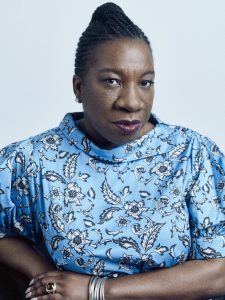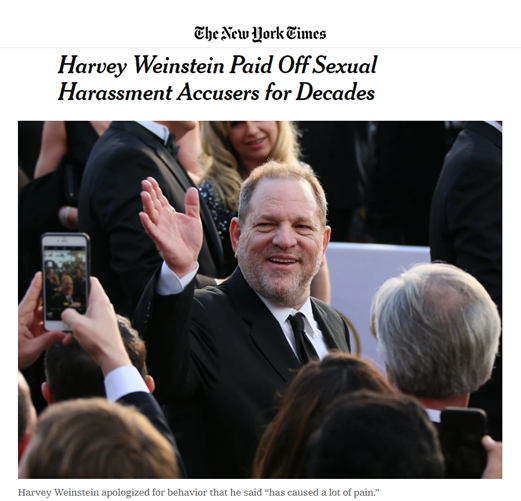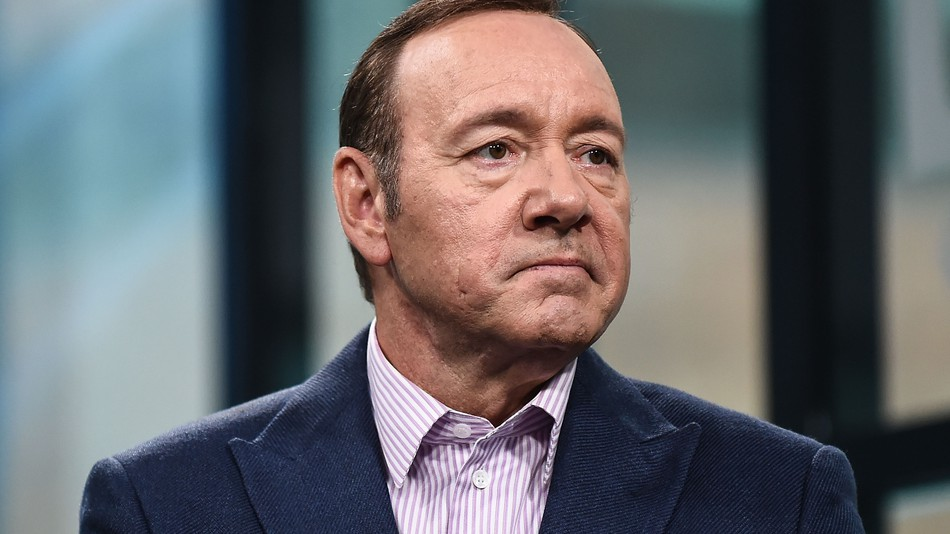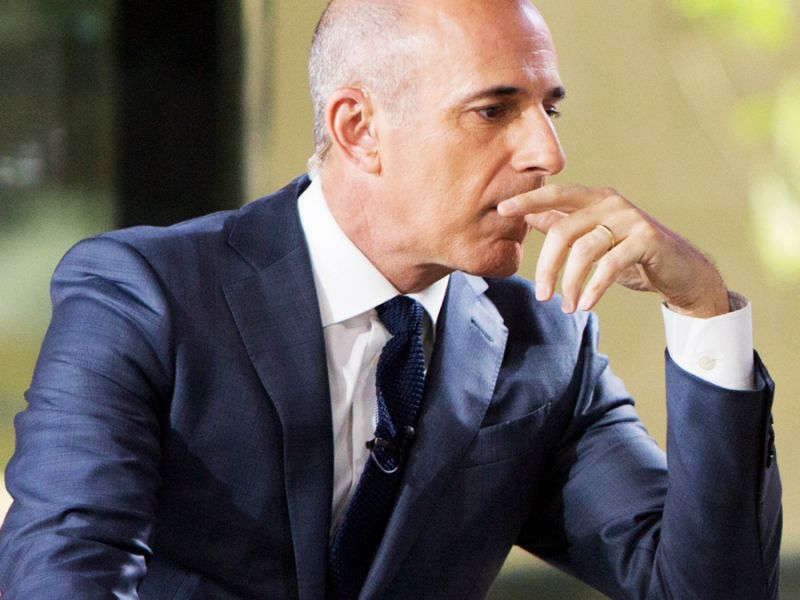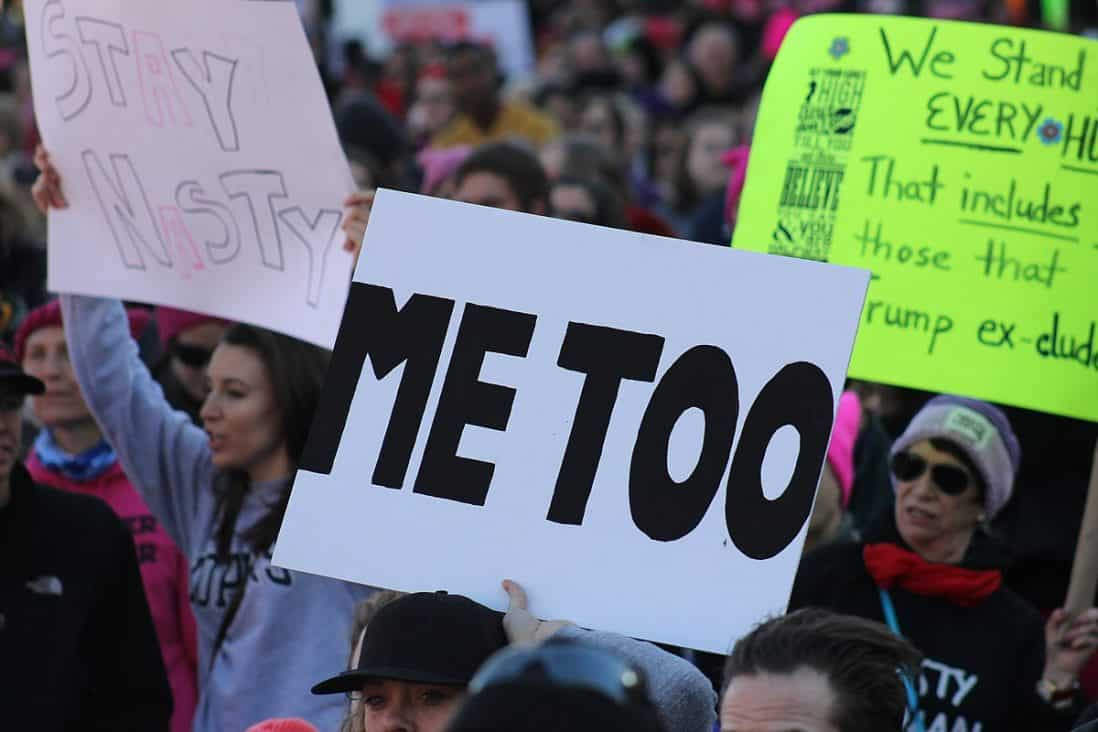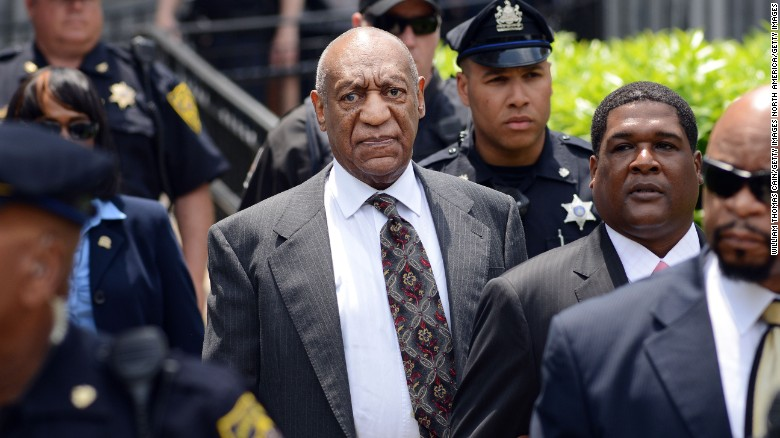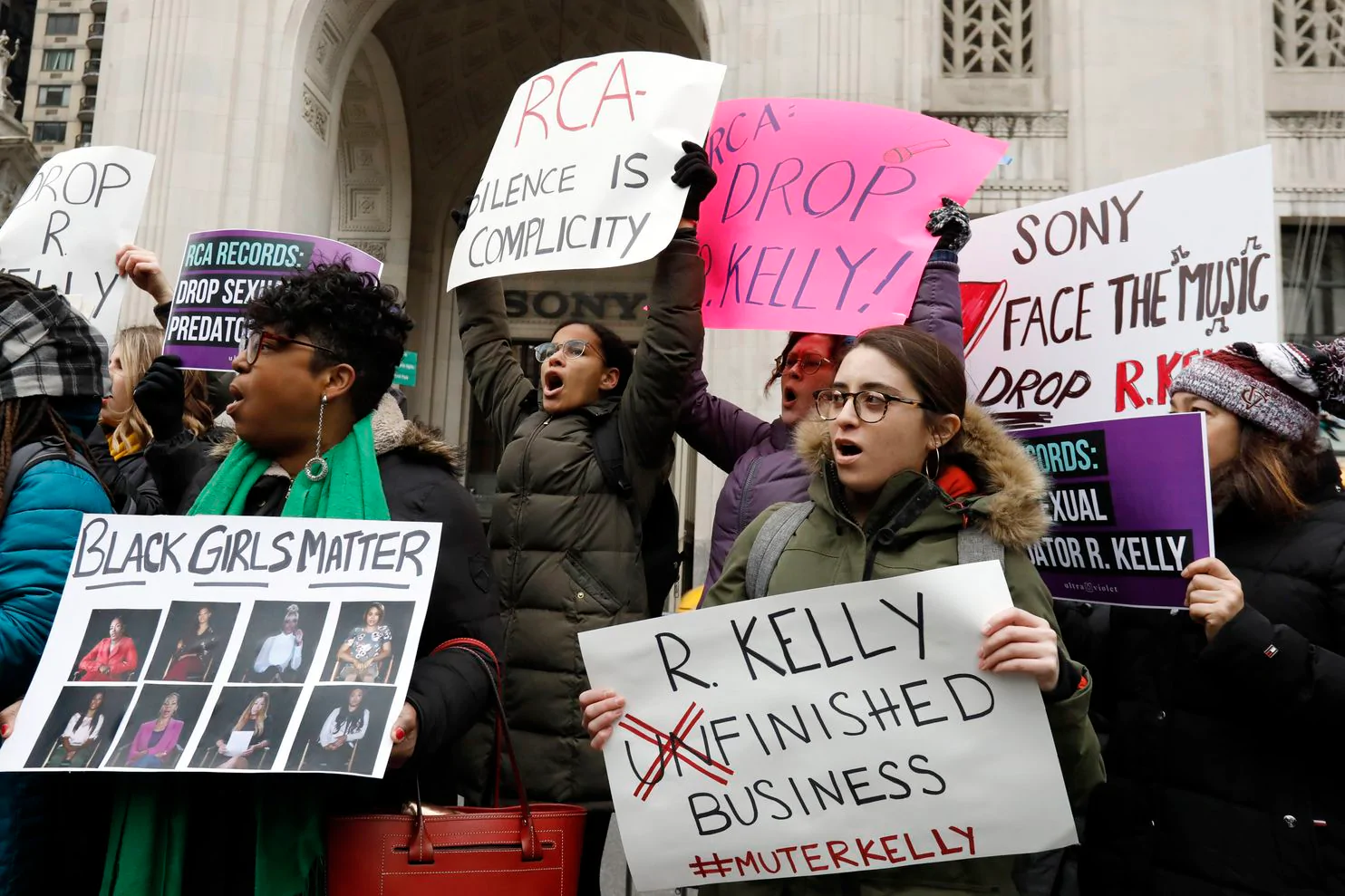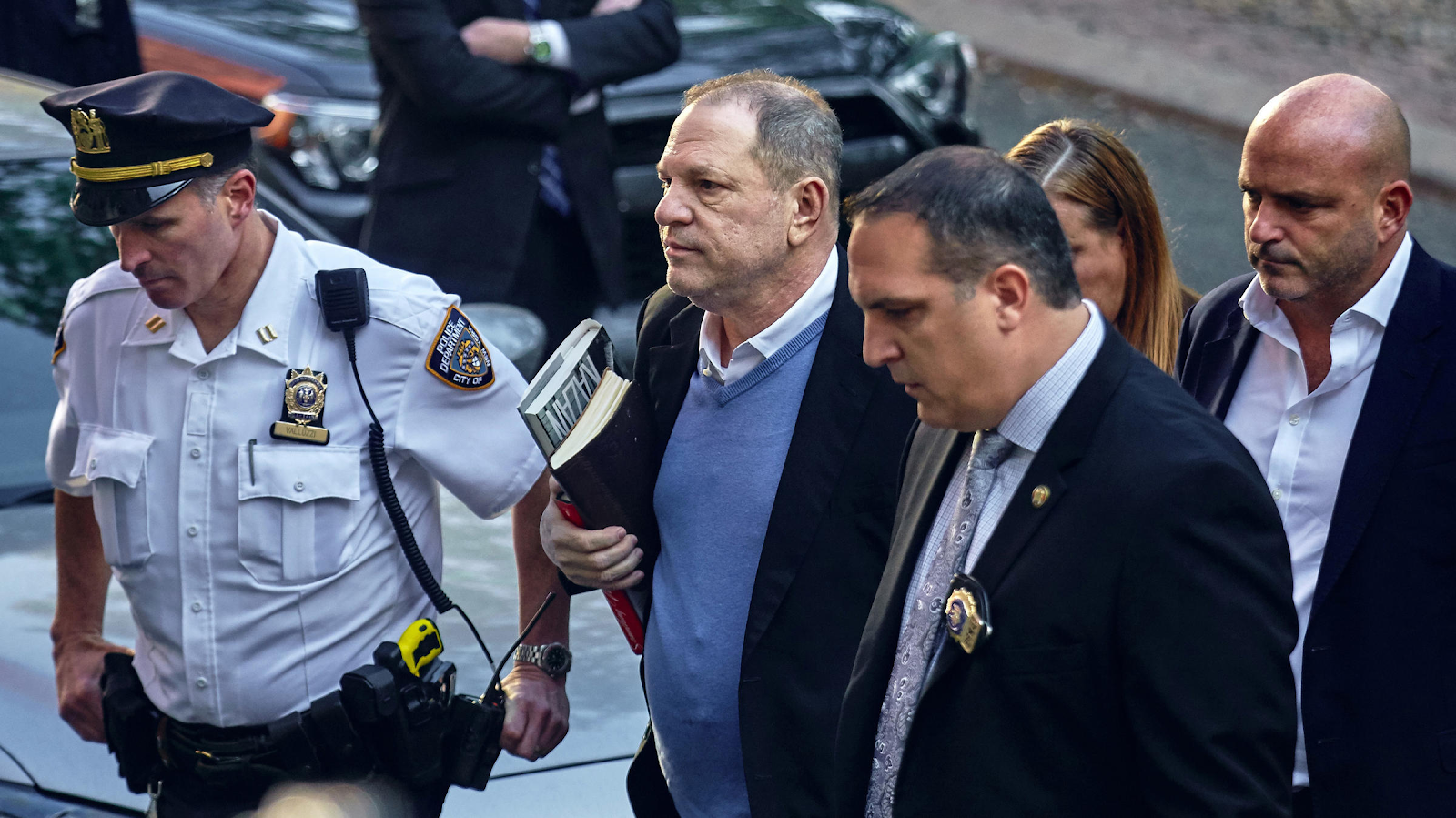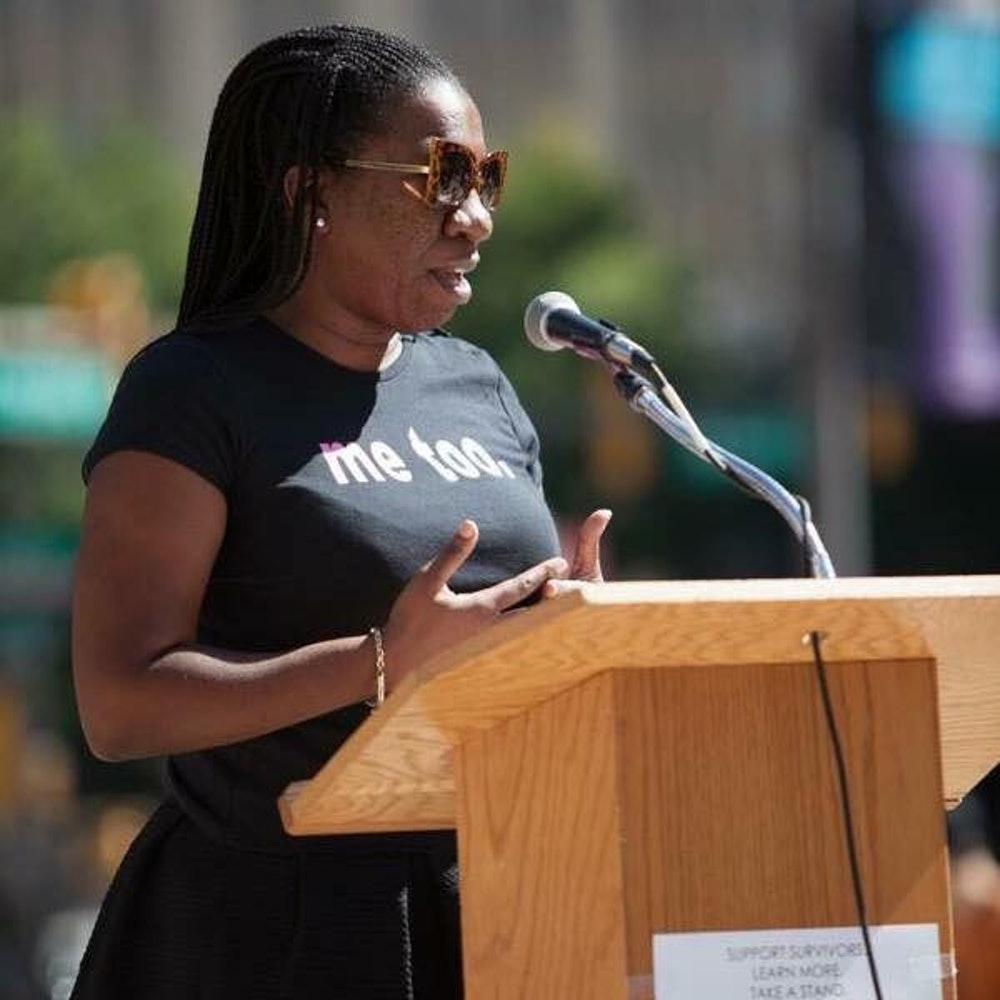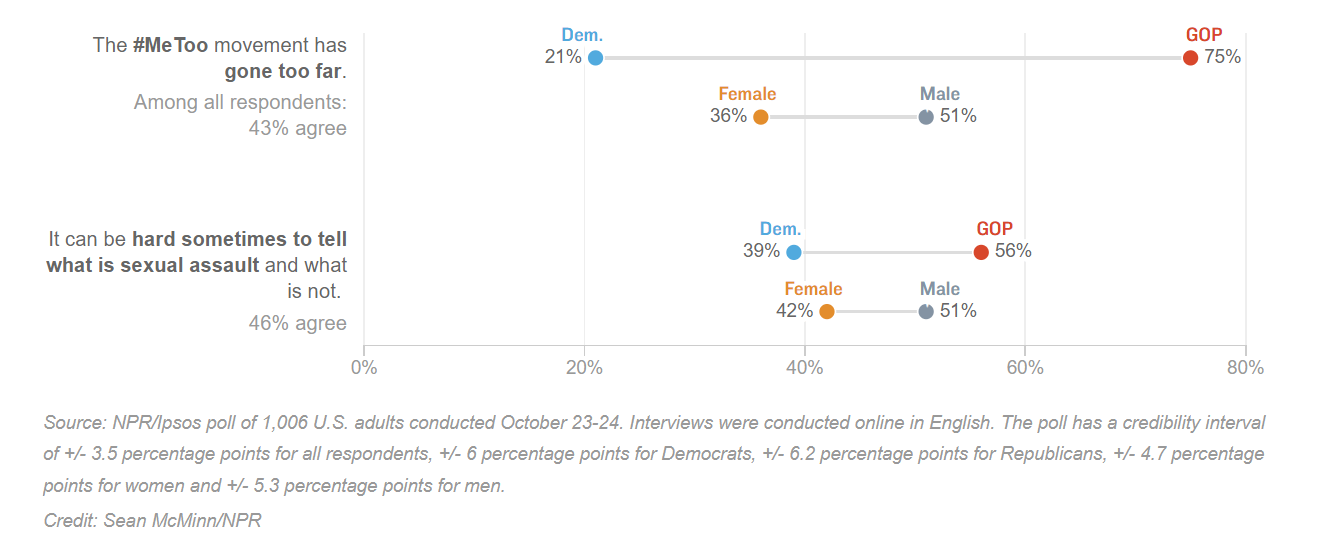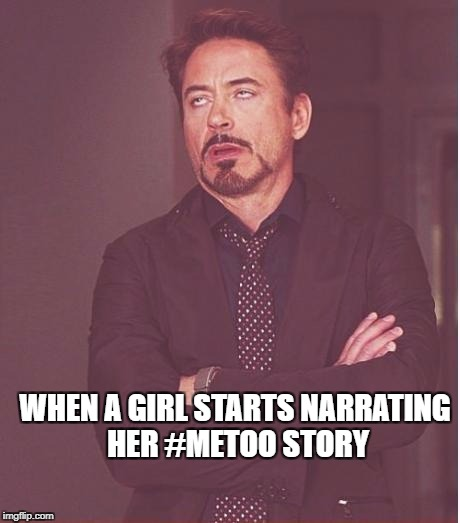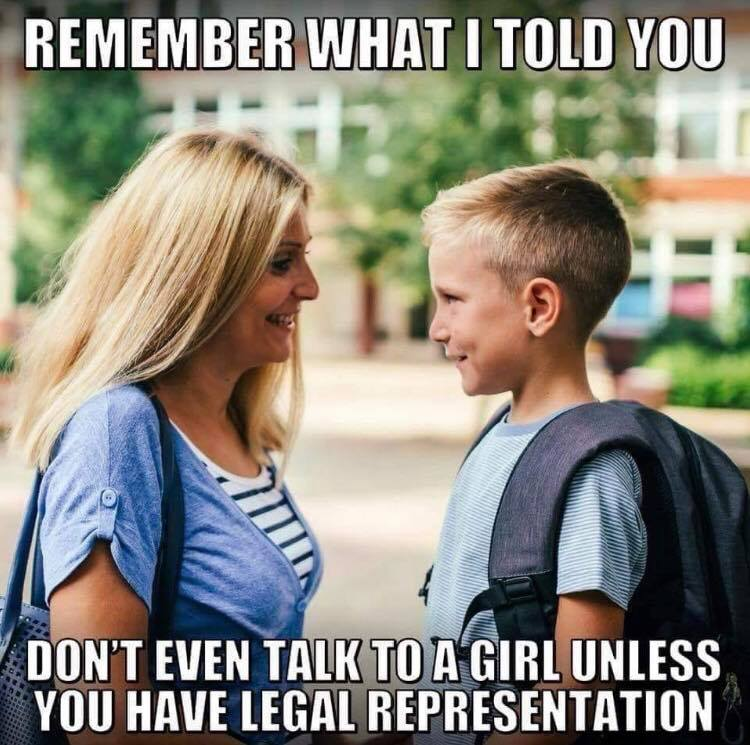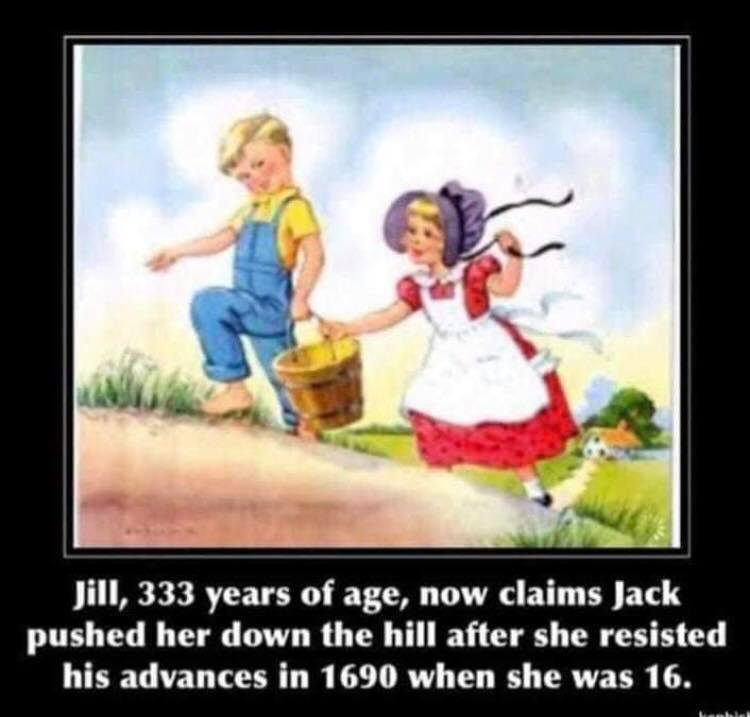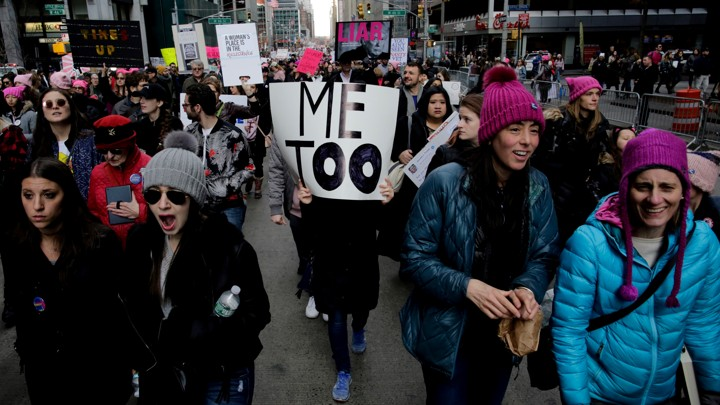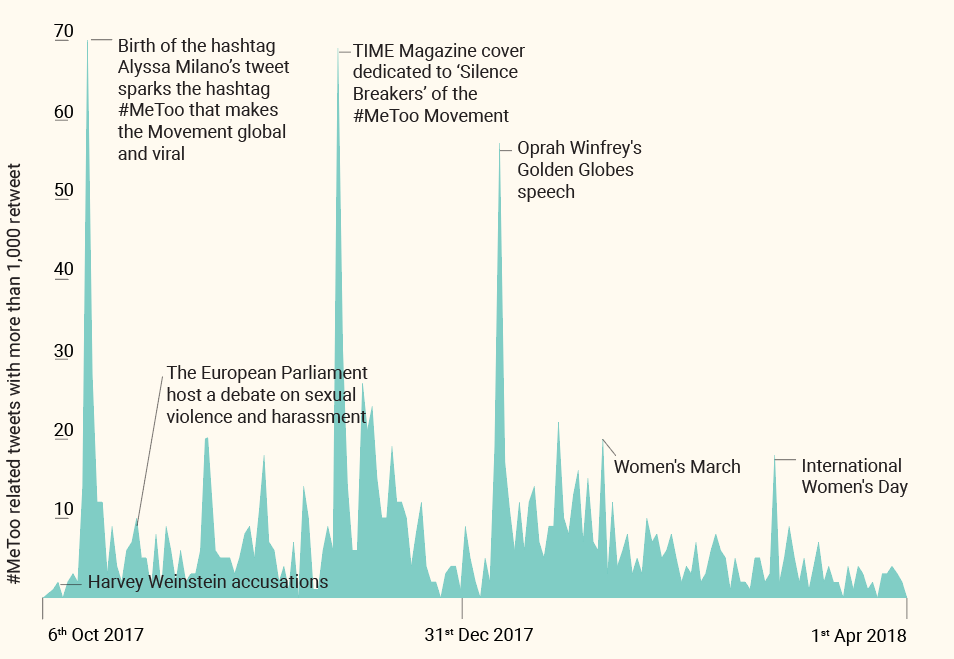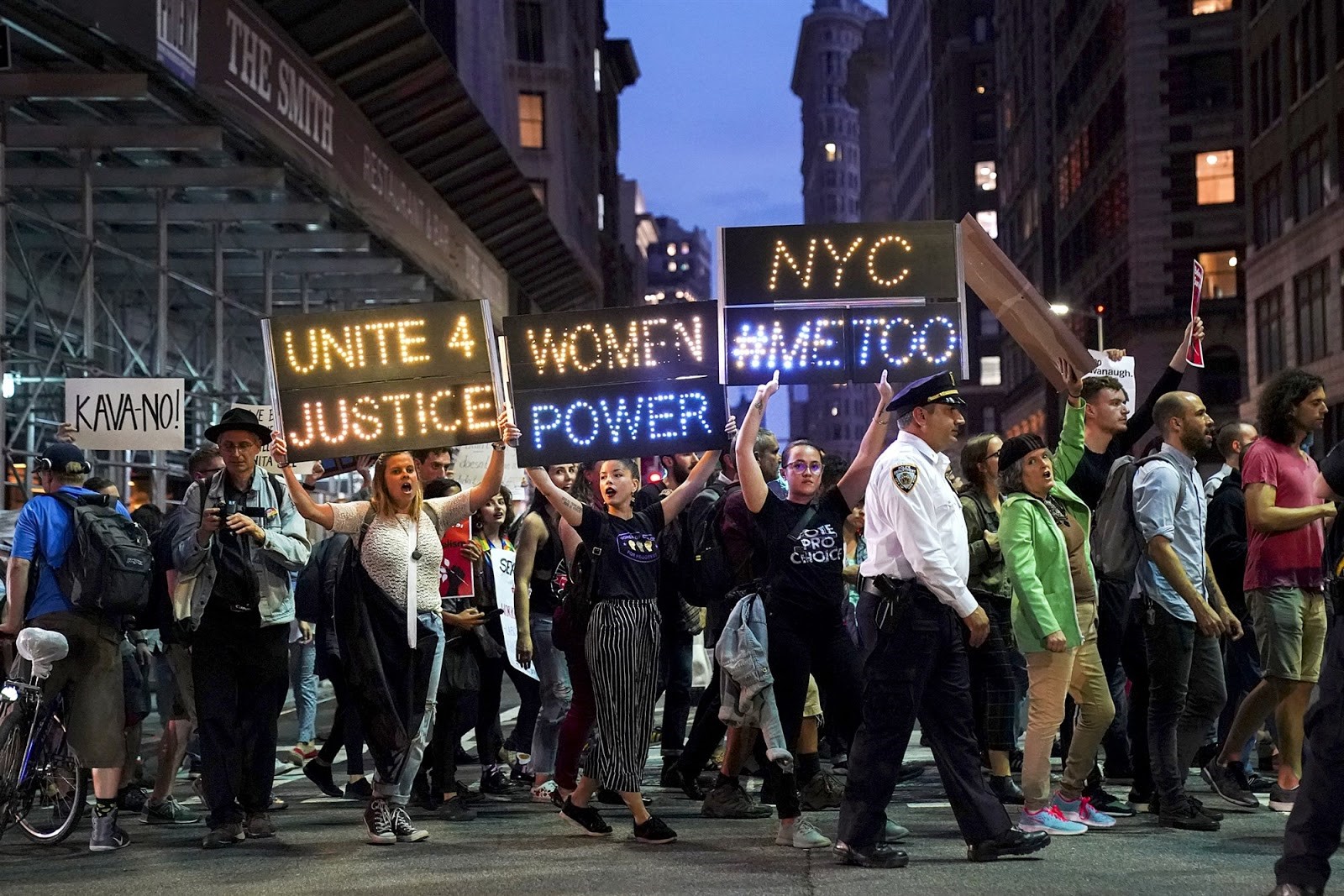PAGE NAVIGATION
- Introduction
- Context
- Key Actors
- Social Media Presence
- Offline Presence
- Impact of the Movement
- Critiques of Movement
- Conclusion
Introduction
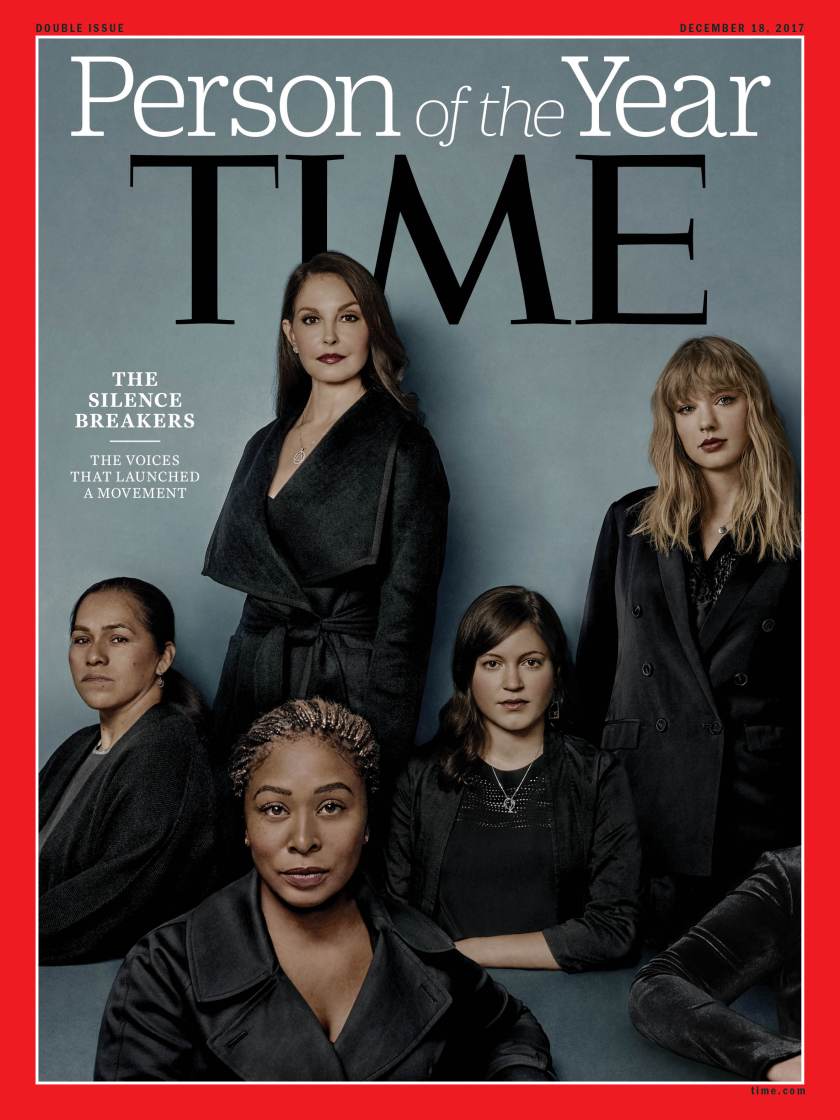
Context
History of #MeToo
Throughout the MeToo movement, thousands of women came out to speak about their experiences with sexual abuse, resulting in a multitude of high profile sexual abuse cases and hundreds of men in prominent positions being forced to step down. The movement spread to other industries, from entertainment, to government, to technology, as women from every industry continued to come forward with their stories.
The MeToo movement is a movement that fights against sexual harassment and assault. It became popular after American actress Alyssa Milano encouraged victims of sexual harassment and abuse to speak up about their experiences using #MeToo on Twitter. This was intended to expose the magnitude of sexual harassment and assault. It was started mainly in response to the dozens of sexual harassment allegations that were brought against movie producer Harvey Weinstein a few days prior. Twitter with its tools and features allowed the fulfillment of this goal, through visibility, allowing anyone to see and interact with the tweets and also through the use of hashtags which makes it possible to document and categorize relevant tweets enabling users to easily follow the movement. A single tweet sparked masses to come together and shed light to an issue just through speaking up on a social media platform which helped form a large and powerful community.[1][2][3]
The movement can be traced all the way back to 2006 when American social activist Tarana Burke founded a nonprofit called Just Be Inc. This organization was created with the purpose of helping survivors of sexual harassment and abuse, with its movement referred to as ‘Me Too’ to empower women through the use of empathy. According to a New York Times interview with Burke, the inspiration behind the title of the movement came from an incident in 1997 where after hearing the story of a 13-year-old sexual abuse survivor at a youth camp, and she was unable to say “me too.”[4]
Not long after Milano’s tweet went out, the movement crossed the borders of the United States and became an international phenomenon. Within a week and a half, 1.7 million #MeToo tweets were generated over 85 countries. This resulted in the creation of many translated or alternative local names such as #BalanceTonPorc (#RatOurYourPig) in France, and #Ana_kaman (“#Me_too”) in the Arab world.[5][6] Conversation on Me Too also arose on Facebook with 4.7 million people talking about it from all parts of the world within 24 hours. Since then, #MeToo has been searched in all 195 countries in the world showing the power and crucial role of social media in mobilizing this social movement.[7]
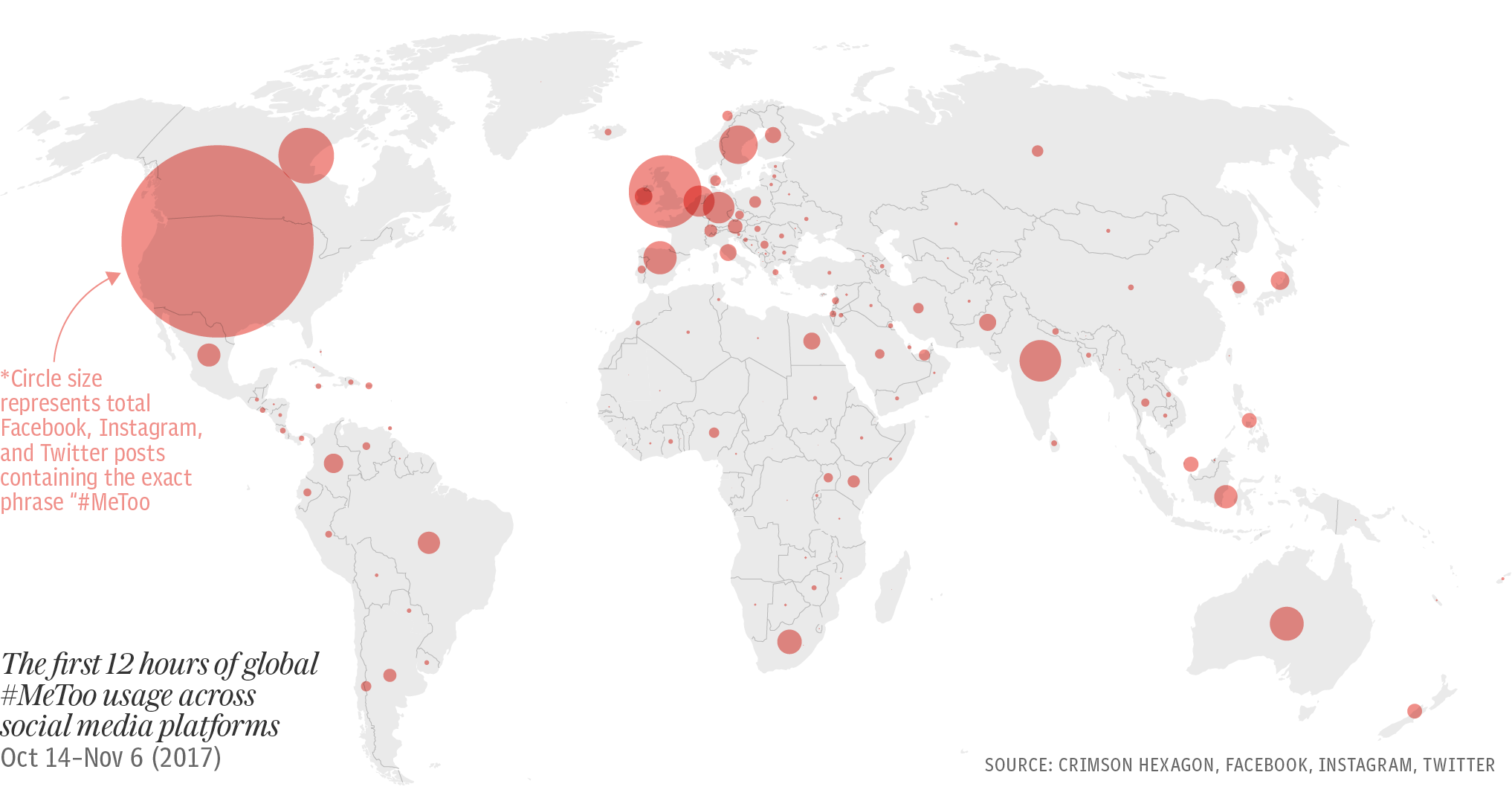
This movement is considered to fall under another overarching movement known as the Women’s Rights Movement, which advocates for the rights of women and promotes gender equality. According to an estimation by the World Health Organization, a third of the global population of women are affected by sexual violence, signaling its prevalence. In the United States, a poll conducted by ABC News and The Washington Post in 2017 revealed that over half of American woman have received “unwanted and inappropriate” sexual advances with 95% further stating that these advances are often left unpunished. However, while the original purpose of the movement was intended to empower women, it has expanded to men as well. A study shows that 1 in 6 men have experienced some type of sexual abuse in their lives, and do not feel they are able to talk about it.[8][9]
The most significant image of the movement to this day as shown above is the 2017 Time magazine cover featuring women who spoke out against sexual abuse dubbed as ‘The Silence Breakers’, who the publication titled as the person of the year. On the cover were Adama Iwu, Ashley Judd, Isabel Pascual, Susan Fowler, and Taylor Swift.[10] According to the magazine’s editor-in-chief, Edward Felsenthal, the decision was made based upon the resulting cultural shift which he deemed as the greatest the world has seen since the 1960’s .[11]
Timeline
The phrase “Me Too movement” was first coined by Tarana Burke, an American activist who created Just Be Inc., a non profit organization with a mission to help victims of sexual assault by providing them the resources they need to heal.[13][14] She created the organization in response to a conversation she had in 1997 with a young girl who was telling her about her experience with sexual abuse. At that time, Burke reflected that she felt speechless, and “couldn’t even say ‘me too.’”[15] In 2006, Burke started a MySpace page for the “Me Too” movement that she wanted to create.[16]
As interest in the Weinstein stories was growing, actress Alyssa Milano tweeted “If you’ve been sexually harassed or assaulted write ‘me too’ as a reply to this tweet.”[20] This tweet quickly went viral, and thousands of women began to tweet with the hashtag #MeToo as a show of support and solidarity with victims of sexual abuse and assault.[21]
First allegation of sexual harassment against Kevin Spacey.
Matt Lauer, co-host of the Today show, was fired after allegations of sexual harassment.

Time magazine named “The Silence Breakers” its “Person of the Year.” This moment showed the cultural impact of the MeToo movement on American society.
Times Up, a coalition of more than 300 women in Hollywood against sexual harassment was formed.
Bll Cosby went on trial. This was the first large celebrity trial of the #MeToo era.
#MuteRKelly culminated into Spotify removing R. Kelly from its featured playlists.
Harvey Weinstein turned himself in after being charged with rape in the first and third degrees.
Christine Blasey Ford accused Supreme Court nominee Brett Kavanaugh of sexual assault. Kavanaugh denied the accusations which led to the rise of the #HimToo hashtag against false rape accusations.
In response to Brett Kavanaugh being sworn into office, Tarana Burke and other activists called a town hall meeting to discuss the future of the MeToo movement and how local organizers can stay involved. She pointed out the need for more inclusion of women of color and other minority groups.[35]
Political Spectrum
While the MeToo movement is not political in nature and does not specifically address one side of the political spectrum, the major events linked to the movement do tend to lean left. For example, #MeToo was prominent during the 2018 Women’s March, which was closely related to anti-Trump administration. #MeToo also became prominent during the Brett Kavanaugh hearings, which became a battle between the left who did not want Kavanaugh sworn in and the right who defended Kavanaugh.
Republicans were also much more likely to say that the MeToo movement had “gone too far” in the sense that it caused society to collectively rush to judgements and give unproven accusations the ability to ruin careers. As illustrated in the visual below, a study by NPR found that 75% of the Republicans surveyed said that the #MeToo movement had gone to far compared to only 25% of the Democrats surveyed.[36]
That being said, Democrats were also affected by the #MeToo era accusations. As of July 26, 2018, 13 Democrats and 12 Republicans had ended their campaigns for elections or re-elections due to sexual harassment allegations.[38]
Location/Affiliation
While the MeToo movement originated in the United States, it slowly spread to other countries around the world. In Spain it was translated to #YoTambien, in Italy it was #QuellaVoltaChe, and in Arab speaking countries it was #AnaKaman.[39]
The following visual shows the top 10 non-english languages that used a translation of #MeToo as a twitter hashtag.
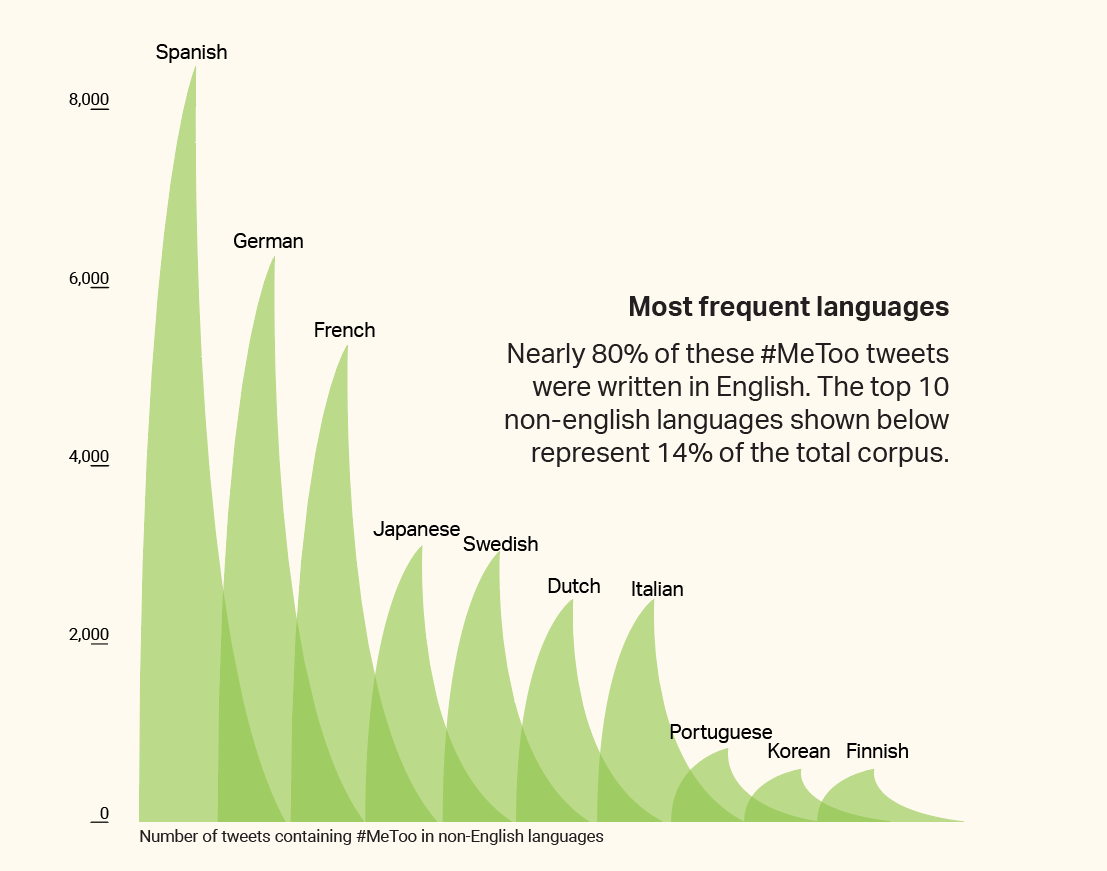 [40]High-profile cases around the world were also ignited as more women publicly stepped out with their allegations. A major victory was when South Korean presidential hopeful, Anh Hee-jung, was sent to prison amidst sexual abuse charges.[41] This was one amongst many resignation cases that arose in South Korea in many different industries as more women began speaking out.
[40]High-profile cases around the world were also ignited as more women publicly stepped out with their allegations. A major victory was when South Korean presidential hopeful, Anh Hee-jung, was sent to prison amidst sexual abuse charges.[41] This was one amongst many resignation cases that arose in South Korea in many different industries as more women began speaking out.
Key Actors
People
Catalyzing the whole Me Too movement, founder Tarana Burke righteously takes much credit for it. She is a civil rights activist from Harlem, New York who was sexually assaulted and raped in her youth. She had been working with victims of sexual violence since the 1990s which inspired her to build the nonprofit Just Be Inc. in 2003, which provided the origins of the Me Too movement. [42][43][44] In line with young women of color as the center of her work, she also serves as the Senior Director at Brooklyn’s Girls For Gender Equity that focuses on the overall development of young women of color through a variety of classes and programs.[45] She was amongst Time Magazine’s list of ‘Silence Breakers’, along with many other prominent female activists.[46]
Alyssa Milano also served an important role in the movement. She was responsible for the tweet that went viral and caused Me Too to resurface, but in a much more significant way helped to create the widespread exposure Me Too received. She, too, was a victim of sexual harassment by the age of 19. Her tweet that involved a call-to-action said “If you’ve been sexually harassed or assaulted write ‘me too’ as a reply to this tweet” [47]
As mentioned previously, this movement gained popularity following the Harvey Weinstein case, cited by The Guardian as the movement’s highest-profile case. Jodi Kantor and Megan Twohey of The New York Times, as well as Ronan Farrow of The New Yorker, published stories on Weinstein and the dozens of women who came forward to accuse him of sexually harassing, assaulting or raping them. After the first article came out, even more women spoke against Weinstein. These include Rose McGowan, Ashley Judd, Mira Sorvino, Salma Hayek, Asia Argento, Cara Delevingne, Uma Thurman, Angelina Jolie, and Rosanna Arquette.[48][49][50]
Demographics
As shown in the following graphs, a nonprofit called Stop Street Harassment conducted an online national survey to assess the landscape of sexual misconduct in the United States. According to the results, 81 percent of woman and 43 percent of men had gone through some type of sexual harassment in their lives (Graph A). Furthermore, the survey revealed that youths were the biggest age group that experienced harassment, specifically around the ages of 14 to 17 for both men and women (Graph B). Lastly, the survey shows the emotional toll victims face as a result of sexual harassment or assault, 31 percent of female survivors reported feelings of anxiousness or depression as a result of the experience (Graph C).[51]



Organizations Involved
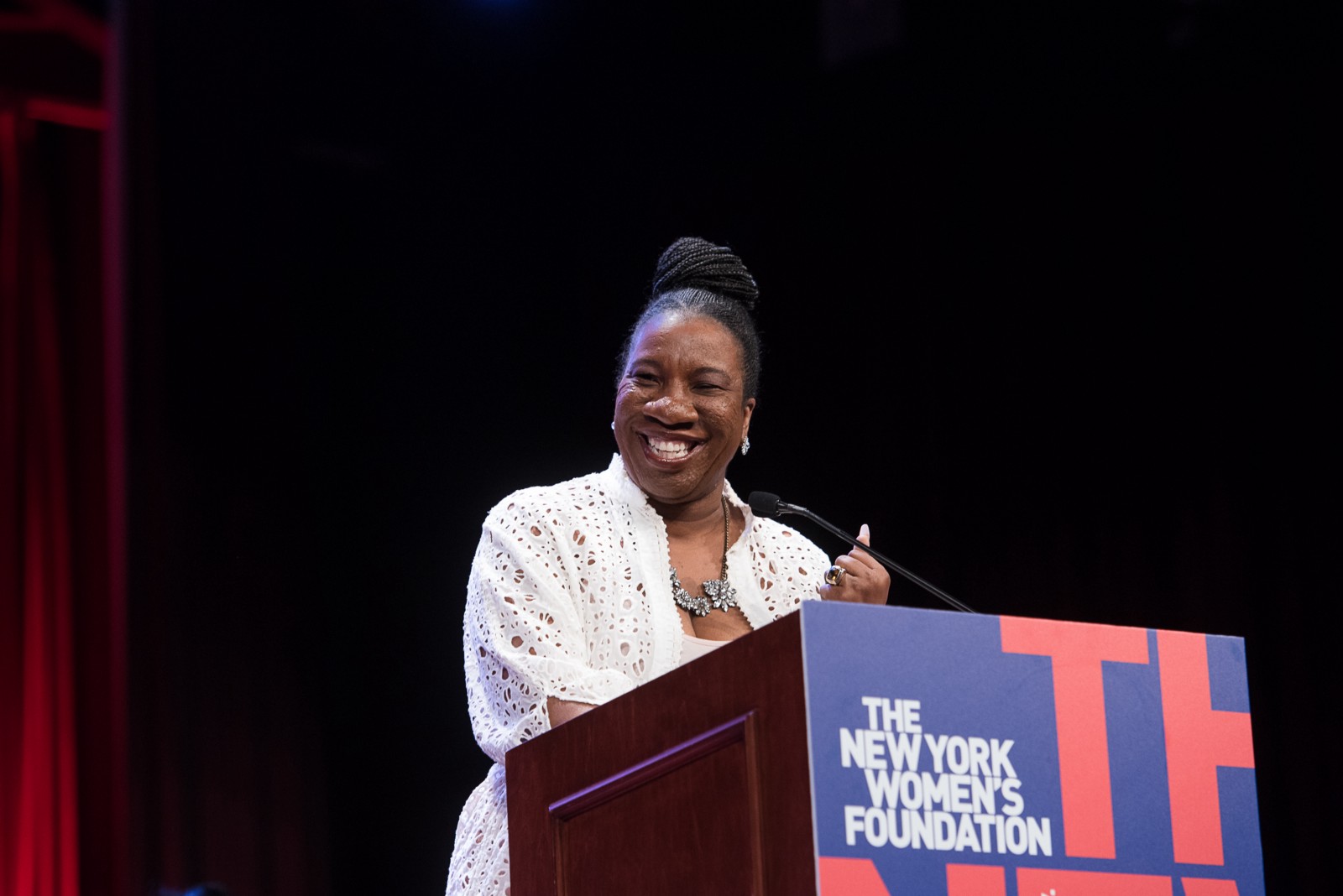
The movement’s ultimate end-goal is to put an end to sexual violence and connect survivors of sexual violence to resources to help them heal. The most prominent organization involved is The New York Women’s Foundation, a nonprofit and leading advocate for gender equality and women’s empowerment. Together with Tarana Burke, the foundation announced the first list of eight grantees that will receive US$840,000 to support their fight against sexual violence in the United States. These organizations include Black Emotional and Mental Health Collective (Los Angeles, CA), Black Women’s Blueprint (National, New York City), DC Rape Crisis Center (Washington, D.C), Equality Labs (National), FreeFrom (Los Angeles, CA), The Firecracker Foundation (Lansing, MI), The “me too” Movement (National), and the Violence Intervention Program (New York City).[52]
Social Media Presence
Platforms Used
Twitter and Facebook were the platforms primarily used for #MeToo. The initial #MeToo hashtag was created on Twitter, and that is where the hashtag was mostly used. However, due to character limits, Facebook also became a popular platform for women to share their stories.[53]MeToo was tweeted nearly 1 million times within the first 48 hours of Alyssa Milano’s initial tweet and more than 12 million posts, comments, and reactions were made about MeToo on Facebook within the first 24 hours.[54]
Popular Hashtags
#TimesUp
#TimesUp is a hashtag movement that was created closely after the #MeToo movement, and worked alongside the MeToo movement in elevating the conversation about women’s rights around the world. While the two movements cover similar topics, the #TimesUp movement is more specific to addressing sexual harassment and gender equity in the workplace. The movement was created by a group of over 300 women in Hollywood who saw the gender inequalities particularly in the entertainment industry.[55] It closely ties in with the MeToo movement because some of the largest sexual harassment allegations that helped the MeToo movement grow, such as the Harvey Weinstein and Kevin Spacey allegations, were all incidents from the entertainment industry.
#BelieveWomen
The #BelieveWomen hashtag is a hashtag that was popularized during the #MeToo movement. It was used in response to some of the criticism that the #MeToo movement was getting about promoting false rape allegations. Much of the opposition to the MeToo movement was aimed at disrupting and questioning the validity of statements made by the women coming out about their sexual abuse experiences. #BelieveWomen was made to counter the opposition that the MeToo movement was getting, especially as those involved in high profile sexual assault cases, such as Brett Kavanaugh and Harvey Weinstein, were denying the allegations made against them.[56]
Most Important Twitter Posts
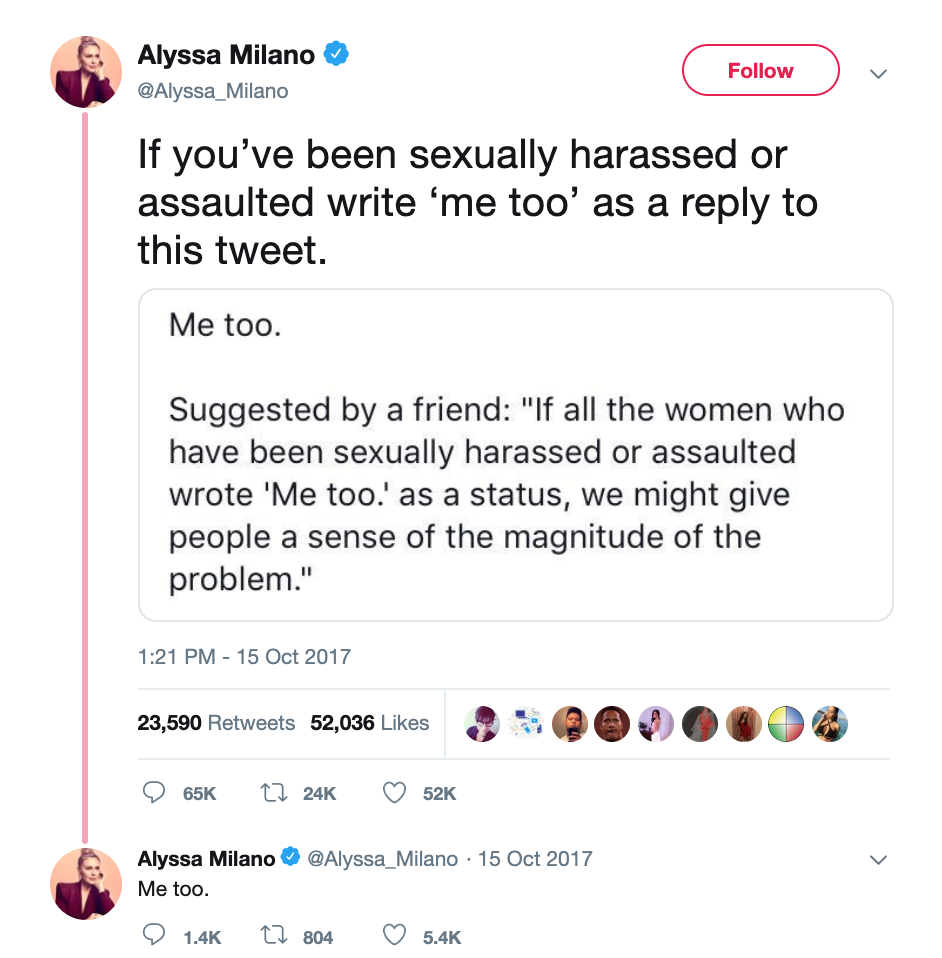
This is the initial Twitter post by Alyssa Milano that began the widespread use of the #MeToo hashtag.[57]
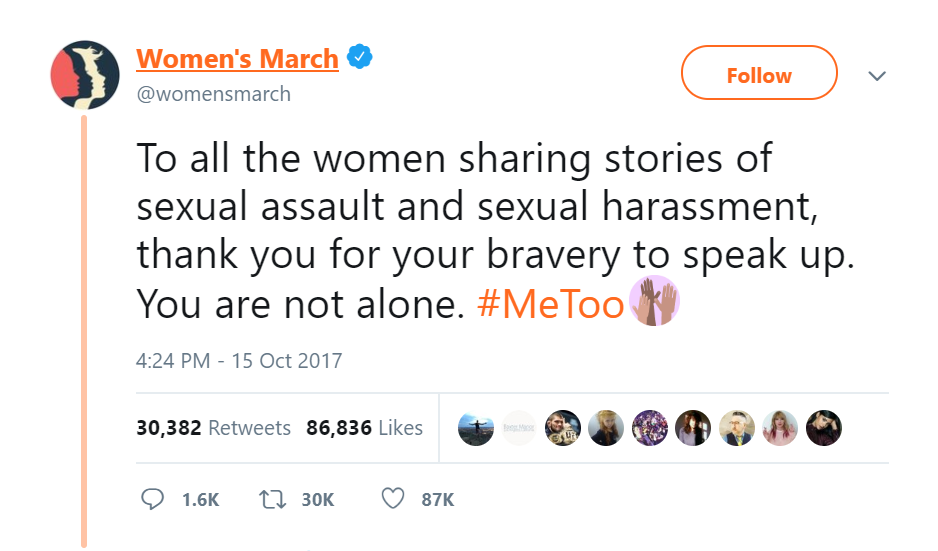
Quickly after the Alyssa Milano’s tweet, the Women’s March Twitter page used the #MeToo hashtag. This is important because it connects the two movements. The Women’s March became more than a retaliation against Trump’s misogynistic comments and became connected to the MeToo movement in a wider movement for all women’s rights including sexual harassment and assault.[58]
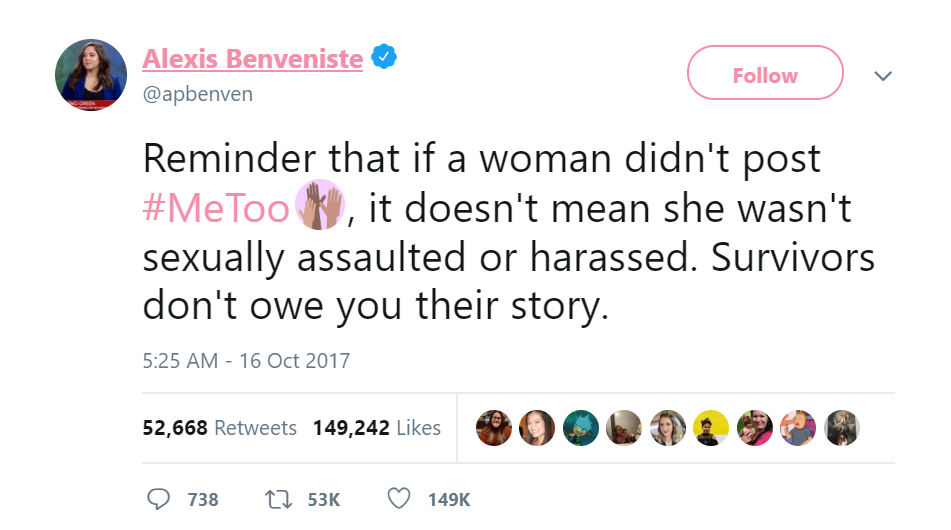
This was one of the most retweeted posts with the hashtag #MeToo at the time of analysis (two weeks after the initial Alyssa Milano post).[59][60]

United States Olympic gymnast, McKayla Maroney, tweeted #MeToo against the team doctor. This was the second high profile #MeToo accusation after Weinstein and signaled the beginning of hundreds of high profile cases to come.[61]
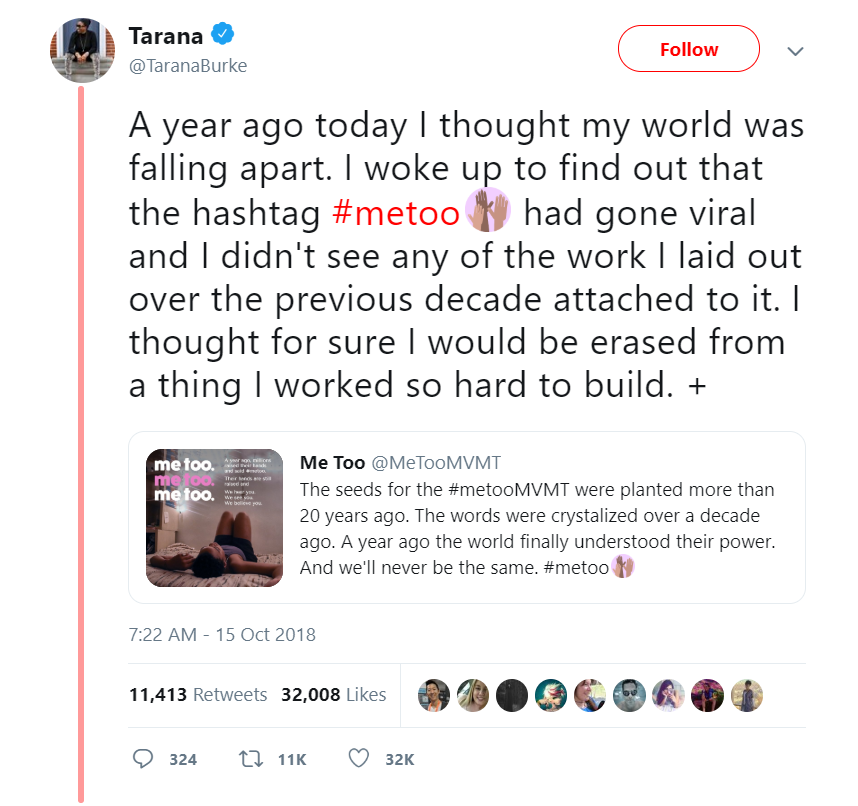
Tarana Burke gave a reflection on the Me Too movement a year after the Alyssa Milano tweet went viral. She pointed out the importance of including women of color in the conversation and the importance of maintaining activism in the aftermath of the social media campaigns.[62]
Meme vs. Cause
Memes related to the MeToo movement were largely created in opposition to the movement. Many of the memes were created to criticize how the movement was a “war on men” where anything done by a man could be subject to questions of sexual harassment. The memes also emphasized the idea of “MeToo exhaustion,” which was the idea that MeToo was starting to get overused.
Despite the majority of the MeToo memes being criticisms against the movement, most of the memes did not get nearly the same widespread attention as the MeToo stories from women who shared their experiences with sexual harassment. As a result, although the memes were largely against the MeToo cause, the memes themselves did little to disrupt the movement.
Analysis
Social media was essential to the MeToo movement. Women’s rights was something that was talked about before, but the MeToo hashtag became essential to giving women a platform to speak out. Before Alyssa Milano’s viral tweet, it was not common practice for women to speak out about their experiences with sexual harassment and abuse because the fear was that they would either lose their jobs or they would be shamed for it. However, the virality of the hashtag expanded the Overton Window and it became more acceptable and even encouraged for women to speak about their experiences. Social media also allowed the movement to grow to a large scale through the usage of networks. A study found that 45% percent of Facebook users had friends that posted about the MeToo movement.[66] Social media allowed the movement to have a large reach, and this allowed the movement to grow globally throughout a multitude of industries.
The #MeToo hashtag is also the perfect example where celebrification made a movement many times more prominent, as many Hollywood actors and entertainment personalities came out to support the movement. Lady Gaga’s retweet of the hashtag alone garnered over 30 thousand likes by October 15th< 2017.[67]
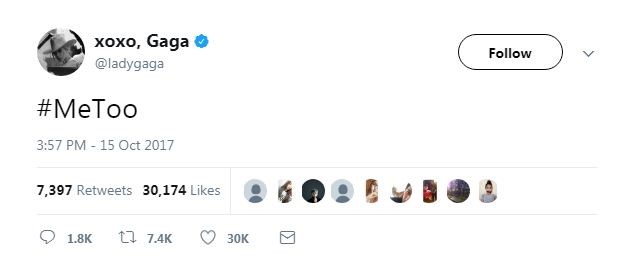
Organic vs. Planned Growth
The rise of the MeToo movement was for the most part organic. When Alyssa Milano first tweeted #MeToo she was not anticipating the huge response she got. The conversations that arose from the MeToo movement about sexual assault and women’s rights were largely from women who naturally felt empowered to speak about the issues as the movement penetrated societal consciousness. There are no direct organizations responsible for planning the growth of the movement, instead the movement helped support other movements that talked about similar issues, such as the Women’s March Movement, the “My Stealthy Freedom” movement in Iran, and the #NudePhotoRevolutionary in Egypt.[68]While some of those movements planned to use attention on the MeToo movement to help their movements grow, the growth of the MeToo movement itself was not planned.
Offline Presence
The MeToo movement had an offline presence that was strikingly apparent during the Women’s March of 2018. For the first time, the hashtag was used in the physical signs that women were carrying.
The use of the #MeToo hashtag was also closely connected to major physical events, such as the Oprah’s Golden Globes speech in 2017, the European Parliament’s debate on sexual violence and harassment, and International Women’s Day. The visual below shows how the use of the #MeToo hashtag spiked when those physical events occurred. This shows that the hashtag wasn’t just used on the internet in isolation from the physical world but the hashtag was linked to offline events and as a result had a stronger presence whenever major offline events related to women’s rights and sexual harassment occurred.
Furthermore, the movement also culminated physically in many of the high profile sexual assault cases following the hashtag accusations. Some of the major cases included the Harvey Weinstein, Bill Cosby, and Brett Kavanaugh cases. #MeToo was featured prominently in rallies and protests particularly during the Brett Kavanaugh hearings.
Analogue Antecedents
While the term sexual harassment had not been coined until the late 1960s, sexual harassment has been around for a very long time. When gender dynamics and the nature of work changed in the 19th and 20th century because of increased number of female workers, it opened the floodgates to men mistreating and sexualizing their female colleagues. [72] Traditionally, women were seen as submissive and domestic, as opposed to the men who go out and work. However, as more and more jobs became available due to the Industrial Revolution in the 19th century, factories began actively hiring more women, especially young girls, widows, and immigrants, in order to take advantage of cheap labor. Unfortunately, these women, without the protection of husbands and fathers, were seen as targets of sexual harassment and abuse. The fact that those women often work in dominantly male work forces exacerbates the problem. [72] Often seen as “invaders” of what were traditionally considered male occupations, the women in male-dominant workforces were often treated with disdain and open animosity. Although the invention of type-writers in the early 1900s gave rise to a new kind of women, one who is dependent on only herself, women who were in the secretarial line of work were also sexualized by the 1920s. By the 1960s, female secretaries’ job prospects were heavily determined by their looks and sexual appeal. [72]
Impact of the Movement
Policy achievements
The hashtag #MeToo went viral almost instantaneously. Twitter’s statistics show that the hashtag #MeToo had been used more than 500,000 times by the end of the second day. [77] On the other hand, the hashtag’s presence on Facebook’s is just as dominant and is used by more than 4.7 million people in 12 million posts during the first 24 hours of it going viral. [77]
The #MeToo movement is the perfect demonstration of celebrification, as hundreds upon hundreds of celebrities joined in on retweeting and reposting. Alyssa Milano aside, popular female celebrities such as Mira Sorvino, Ashley Judd, and Lady Gaga increased the popularity by many folds. Lady Gaga’s retweet of the hashtag alone garnered over 30 thousand likes on October 15th 2017, [73] while Alyssa Milano’s original tweet received more than 50 thousand likes during that time. [75][75]
On November 15th 2017, Jackie Speier proposed the ME TOO Congress Act to the Congress. [74][76] The bill’s main purposed is to change how sexual harassments are treated legislatively. Under the new bill, future complaints of sexual harassment will take only up to 180 days to be filed, compared to the old system which took significantly longer. [74][78] In addition, workers who are under the presence of alleged harasser are allowed to switch departments without having to lose their jobs. [74][78] The Office of Compliance must also make public harassment settlements. [74][78]
Movements inspired my #MeToo
#MuteRKelly
American R & B singer Robert “R” Kelly has always had a career filled with multiple scandals, as well as sexual abuse allegations. The #MuteRKelly movement was founded in July 2017 by Atlanta Arts Administrator Oronike Odeleye after reports of him sexually harassing 14-year-old girls came into public attention. [79] When a six-part documentary series on the multiple sexual allegations in Kelly’s career went on air on Lifetime in January 2019, [81] public interest in the topic became increasingly significant, until eventually, the singer was dropped by his record company, Sony Music, on January 18th. [82] Other music streaming services and companies such as Apple Music, Youtube, and Spotify acted too. As a result Spotify, while still has Kelly’s music available in its library, no longer promotes his songs to its subscribers. [83] In February, the singer was charged with 10 cases aggravated criminal sexual abuse, 9 of which involved minors. [80]
#TimesUp
#TimesUp was inspired by the MeToo movement, and was directly founded and financially supported by multiple Hollywood celebrities, such as Jennifer Anniston and Taylor Swift. [84][85][88] The main aim of the movement is to supply sufficient platform and funds to people who wish to speak up about sexual harassment. [85] The movement aims to provide a 13 billion legal defense fund to help lower-income victims of sexual harassment seek justice.[89] It also calls for legislation that punish companies and agencies who allow harassment in the workplace, as well as supporting a movement towards a more gender equal culture in those companies and agencies. [88] One success the movement had was encouraging attendees of the 75th Golden Globe Awards to wear black, and speak out against sexual harassment. [87] Another was when figures such as Lady Gaga, Lana Del Ray, and Kesha decided to wear white roses or black outfits to sympathize with the movement during the 2018 Grammys. [86]
#BelieveWomen
The #BelieveWomen hashtag refers to the need to believe in women who puts forward cases of sexual harassment that are committed against them. This is a response to the false rape allegations, as the hashtag wishes to point out that even though false rape allegations do exist, they are not nearly as common as ones that were true. [90] This tag became increasingly popular during the Kavanaugh hearings, as a response to President Donald Trump nominating Brett Kavanaugh, who was accused by Dr. Christine Blasey Ford of sexually assaulting her during their high school times. [89] This movement, however, is not without its criticisms. For a start, the inclusiveness of this movement came under heavy scrutiny, when Vanessa Tyson’s accusation of Virginia Lt. Gov. Justin Fairfax for sexual attention received comparatively less attention. This sparked the conversation that the left didn’t believed in “all women,” due to this perceived hesitation to support Tyson, a Democrat. [91]
#HimToo
This is often perceived as a popular backlash against the #MeToo movement. The #HimToo, also referred to as the Him Too Movement, is a Twitter hashtag that refers to the social media campaign against false rape allegation. [92][94] The #HimToo hashtag was first started by a mother of a Navy vet who claimed on Twitter that her son “won’t go on solo dates due to the current climate of false sexual accusations by radical feminists with an axe to grind.” [92] The tweet was soon deleted, but the hashtag itself still went viral and is used to bring attention to false accusations of rape against men. [92][94] It was further popularized after the Kavanaugh hearings. [93] #HimToo is often seen as a backlash and a direct contradiction to the #MeToo movement because of its focus on defending the accused instead of the victims of rape and sexual violence. Criticism of the #HimToo hashtag centers around the fact that #HimToo over exaggerates the occurrence of false rape allegations, which in turn can hurt the victims. [93]
#IDidThat #IHave #IWill
The hashtags -#IDidThat, #IHave and #IWill are similar in that they put the focus on the abuser and the perpetrator of sexual violence, or people who are not directly affected by sexual harassment, rather than on the victims. [95] Feminists have voiced frustration that it is not the burden of the victims to fix the perpetrators. #IDidThat and #IHave, are responses in support of the #MeToo movement from the male side. Men who had committed sexual harassment or assault, willfully or unintentionally, or men who had stood by and watched instead of taking action in the face of other men sexually harassing women, are using the hashtags to self-reflect on their past actions, and to support the #MeToo movement. [96]
#IWill, on the other hand, is a hashtag for people to voice their own commitment to stopping sexual violence. However, it was also perceived that while #IWill is not gender specific like #IDidThat and #IHave, it is mostly used by women, and not by men. [97]
Critiques of Movement
As with any other movements, the Me Too movement has also received a variety of criticisms. These can be categorized into four broad topics: a) Criticisms of Tarana Burke, b) Lack of Clarity and Unity, c) Implications, and the largest of them all d) Exclusion, Unfair Representation and Lack of Divided Attention.
Criticisms of Tarana Burke
When Alyssa Milano’s tweet blew up, Burke started to worry that the viral tweet with the #MeToo hashtag would overpower the original Me Too movement that she has been working on for over a decade:[99]
- Losing its mission:Burke’s intention with the original Me Too movement was to connect victims of sexual violence to the resources they need so that they could heal from the traumatizing experience. She exerts that Me Too is more than just a hashtag, but a strategy that requires real work, which does not reflect the current atmosphere and progress of the movement.
- Losing its attention to the marginalized community: In the process of gaining popularity, #MeToo was mostly spread and boosted by white women, despite the fact that its origins came from a woman of color. Burke suggested that significantly less attention is being given to women of color, and says that it seems as though the media does not care about their stories.
- Losing its meaning: Burke suggests that the phrase “me too” has become overused to the point that it has become a punchline, with Lee Daniels even making a Me Too comedy. In a conversation with the New York Times, she implies that the virality of Me Too, while has its positive effects, also has its downside such as possibly losing the meaning of the phrase and causing people to be numb to the issue it addresses.[100][101]
Lack of Clarity and Unity
The end goal of the movement has been up for debate, implying its lack of clarity with discussions such as whether the Me Too movement is meant to stimulate change within the entire male population or just a subset of them. Some women have argued the latter, and further stating that only the worst cases of abuse should be targeted to prevent the generalization of all men as guilty of such actions. Furthermore, these women want to avoid the possible encouragement of sentiments against all men through widespread coverage.[102][103]
Implications
#HimToo: As stated earlier the Me Too movement saw the rise of a counter-movement known as the Him Too Movement (or #HimToo). It went viral in October 2018 and is targeted at false rape allegations that rose with #MeToo. To provide context, while more people are speaking about their experience of sexual harassment and assault, there also have been cases where the allegations made turned out to be untrue.[104] Numbers provided by the U.S. Department of Justice and other organizations estimated that 2-10% of rape allegations are false.[105] As such, there have been conversations about believing an accuser before ensuring the accuracy of the allegations made and whether victims of false allegations are punished even before being proven guilty. This was responded by yet another hashtag, #BelieveWomen, with the purpose of “(recognizing) that false allegations are less common than real ones”.[106]
Debate over consequences: Another criticism is those discussing the warrant for harsh consequences for some cases of alleged sexual harassment, is often defamation especially for the likes of well-known figures.[107] Some celebrities have criticized the generalization of sexual misconduct instead of considering its different degrees, and Matt Damon stated that this encourages men as well as the younger generation to deny any allegations in order to avoid their lives getting ruined.[108] In addition, Liam Neeson suggested that some of the accused, such as Dustin Hoffman, received unfair treatment.[109] Harper’s Bazaar’s Jennifer Wright, however, argued that belief and fear of overcorrection imply that people are unable to come to terms with the thought that “likable men can abuse women too”.[110]
Reliving trauma: Also, there have been talks over the possible repercussion of the Me Too movement rooted from the attention and publicity that the victims receive, which could be a re-traumatizing experience.[111]
Exclusion, Unfair Representation, and Lack of Divided Attention
Sex workers and sex trafficking victims: Some people have proposed that the movement should be extended to sex workers and sex trafficking victims. The underlying reason for these calls is that those who fall under these categories are more victimized than any other group. However, there are those who disagree and suggest that there is a reason to target them and that they are deserving of the sexual harassment and assault that they receive.[112] Clinical psychologist and research Melissa Farley assert that even when there is consent, the nature of prostitution is seen as being forced to provide sexual services to earn a livelihood, qualifies it as a form of sexual assault. Many sex workers expressed their disagreement with Farley, stating that her way of thinking condemns prostitution.[113]
Incarcerated women: Prison rape is a common occurrence amongst many other sorts of abuse as a result of the notably restricted rights of prisoners together with the existing power imbalance between female inmates and the male officers.[114] Furthermore, these women in prison who were sentenced over the murder of their partners more often than not acted in the form of self-protection.[115] As such, there has been much criticism over the punishment abused women receive for defending themselves, which people have criticized the Me Too movement for failing to address or incorporate in its outreach.[116]
Law enforcement: Some have criticized the lack of discussion with regards to sexual misconduct within the industry of law enforcement in the Me Too movement.[117] A report published in 2010 by the Cato Institute revealed that over almost 1 in 10 of incidents of misconduct within the police department were in relation to sexual abuse, as well as that there are multiple reasons to believe that sexual assault rates in this subgroup are much higher compared to the general population.[118] While some states have laws in place to decertify those guilty of major misconduct such as Florida and Georgia, police-reform activist Roger Goldman states that in other cases, an officer who is fired can simply apply to a different department. As such, some have suggested that third parties should come in to investigate sexual misconduct allegations rather than colleagues to reduce bias.[119]
Minority women: Women who are part of the minority are more likely to be victims of sexual harassment, yet many have expressed their lack of representation in the movement and pointed out that the leadership is predominately white women.[120][121] Industries that see the most amount of sexual misconduct allegations such as hotels, food and beverage, retail, and health are the same industries where the majority of the workers are minority women.[122] Also, it has been articulated that those belonging to the same group and are undocumented have no possible course of action after they have victimized. Furthermore, former victim Farah Tanis claims that black women face an additional set of barriers with regards to participating in the movement due to the social pressure they receive to not speak out to avoid being seen as someone who betrayed their own “brothers,” and also because if they do speak out, it’s less likely that anyone would believe them.[123][124]
Others: Some have pointed to the movement placing too heavy of a public focus on the accused and the consequences they face, and not enough on those experiencing sexual abuse.[125] They have opined that some attention should be shifted to discussing the implementation of new policies or making changes to institutional norms that would serve both current and future sufferers.[126] Furthermore, cases involving victims that are well-known public figures receive the most attention, while minimal light is shed on the victims belong to the rest of the society such as regular workers.[127]
Conclusion
The Me Too movement has made a significant impact on the conversation about sexual harassment and sexual abuse around the world ever since Alyssa Milano’s #MeToo tweet went viral. People from all around the world have come out to speak about their experiences with sexual abuse using the #MeToo hashtag, and it has led to numerous high-profile sexual assault cases and powerful men stepping down from their positions.
Social media played a crucial role in the development of this movement. The #MeToo hashtag was shared by millions all over the world within days of the viral tweet because of social media’s ability to reach across networks of people. The movement took on new forms as it adapted to the context of different countries, and that allowed the movement to sustain itself around the world.
Social media also helped enhance the movement as it began to take more physical forms, particularly in protests and speeches. The Me Too slogan began to appear on physical signs in protests, and the hashtag was continuously used to support later events such as The Women’s March, Oprah Winfrey’s Golden Globes Speech, and the My Stealthy Freedom movement in Iran.
Despite its criticisms, the Me Too movement has undoubtedly brought to attention the widespread effects of sexual abuse. The implications of the movement continue today, with numerous sexual assault cases still pending and more women and men stepping out to share their stories.
Author Biographies
Isabel Zou
Isabel is a third year student studying Business Administration at UC Berkeley. She is very interested in how technology can be used to develop innovative solutions to social and environmental issues around the world.
Nicole Gonzales
Nicole is a graduating student doing a double major in Marketing and Management at the University of Melbourne but currently on exchange at UC Berkeley. Before pursuing her Commerce degree, she graduated as a communications student specializing in Public Relations and Marketing Communications in Singapore. She one day hopes to make a difference in the world.
Bruce (Zhaolong Li)
Bruce is a senior at UC Berkeley studying English and Computer Science. He is interested in digital humanities and journalism, and looks forward to a wider application of technology in the humanity fields of study.
Sources
[1] Pflum, Mary. “A Year Ago, Alyssa Milano Started a Conversation about #MeToo. These Women Replied.” NBCNews.com, NBCUniversal News Group, https://www.nbcnews.com/news/us-news/year-ago-alyssa-milano-started-conversation-about-metoo-these-women-n920246
[2] Vagianos, Alanna. “Alyssa Milano Marks 1 Year Of Me Too With Heart-Wrenching Message To Her Daughter.” HuffPost, HuffPost, 16 Oct. 2018, https://www.huffpost.com/entry/alyssa-milano-marks-1-year-of-me-too-with-heart-wrenching-message-to-her-daughter_n_5bc4cbe2e4b01a01d68d4f3e
[3] France, Lisa Respers. “#MeToo: Social Media Flooded with Personal Stories of Assault.” CNN, Cable News Network, 16 Oct. 2017, https://www.cnn.com/2017/10/15/entertainment/me-too-twitter-alyssa-milano/index.html.
[4] Garcia, Sandra E. “The Woman Who Created #MeToo Long Before Hashtags.” The New York Times, The New York Times, 20 Oct. 2017, www.nytimes.com/2017/10/20/us/me-too-movement-tarana-burke.html.
[5] Donadio, Rachel. “#BalanceTonPorc Is France’s #MeToo.” The Atlantic, Atlantic Media Company, 18 Oct. 2017, www.theatlantic.com/international/archive/2017/10/the-weinstein-scandal-seen-from-france/543315/.
[6] Zacharek, Stephanie, et al. “TIME Person of the Year 2017: The Silence Breakers.” Time, Time, time.com/time-person-of-the-year-2017-silence-breakers/.
[7] “More than 12M ‘Me Too’ Facebook Posts, Comments, Reactions in 24 Hours.” CBS News, CBS Interactive, www.cbsnews.com/news/metoo-more-than-12-million-facebook-posts-comments-reactions-24-hours/.
[8] Zillman, Claire. “A New Poll on Sexual Harassment Suggests Why ‘Me Too’ Went So Insanely Viral.” Fortune, Fortune Media, fortune.com/2017/10/17/me-too-hashtag-sexual-harassment-at-work-stats/.
[9] Radu, Sinthia. “How a Simple #MeToo Amplified Women’s Experiences Around the World.” U.S. News & World Report, U.S. News & World Report, www.usnews.com/news/best-countries/articles/2017-10-25/how-metoo-has-awoken-women-around-the-world.
[10] Zacharek, Stephanie, et al. “TIME Person of the Year 2017: The Silence Breakers.” Time, Time, time.com/time-person-of-the-year-2017-silence-breakers/.
[11] Ibid.
[12] Union, Gabrielle. “Tarana Burke.” Time, Time, time.com/collection/most-influential-people-2018/5217577/tarana-burke/.
[13] Garcia, Sandra E. “The Woman Who Created #MeToo Long Before Hashtags.” The New York Times, The New York Times, 20 Oct. 2017, www.nytimes.com/2017/10/20/us/me-too-movement-tarana-burke.html.
[14] Harris, Aisha. “She Founded Me Too. Now She Wants to Move Past the Trauma.” The New York Times, The New York Times, 15 Oct. 2018, www.nytimes.com/2018/10/15/arts/tarana-burke-metoo-anniversary.html.
[15] Garcia, Sandra E. “The Woman Who Created #MeToo Long Before Hashtags.” The New York Times, The New York Times, 20 Oct. 2017, www.nytimes.com/2017/10/20/us/me-too-movement-tarana-burke.html.
[16] Ohlheiser, Abby. “Meet the Woman Who Coined ‘Me Too’ 10 Years Ago – to Help Women of Color.” Chicagotribune.com, 19 Oct. 2017, www.chicagotribune.com/lifestyles/ct-me-too-campaign-origins-20171019-story.html.
[17] Kantor, Jodi, and Megan Twohey. “Harvey Weinstein Paid Off Sexual Harassment Accusers for Decades.” The New York Times, The New York Times, 5 Oct. 2017, www.nytimes.com/2017/10/05/us/harvey-weinstein-harassment-allegations.html.
[18] Ibid.
[19] https://twitter.com/alyssa_milano/status/919659438700670976
[20] Johnson, Christen A. “#MeToo: A Timeline of Events.” Chicago Tribune, Chicago Tribune, 7 Mar. 2019, www.chicagotribune.com/lifestyles/ct-me-too-timeline-20171208-htmlstory.html.
[21] Remnick, David. “One Year of #MeToo.” The New Yorker, The New Yorker, 10 Oct. 2018, www.newyorker.com/news/news-desk/one-year-of-metoo.
[22] Morse, Jack. “Kevin Spacey Tweets Bizarre Video after Sexual Assault Charge.” Mashable, Mashable, 24 Dec. 2018, mashable.com/article/kevin-spacey-sexual-assault-charge-video-response/.
[23] González-Ramírez, Andrea. “Matt Lauer Addresses The Sexual Harassment Allegations Against Him.” Yahoo!, Yahoo!, 30 Nov. 2017, www.yahoo.com/lifestyle/bombshell-report-details-matt-lauer-211400639.html.
[24] Zacharek, Stephanie, et al. “TIME Person of the Year 2017: The Silence Breakers.” Time, Time, time.com/time-person-of-the-year-2017-silence-breakers/.
[25] “TIME’S UP Now.” TIME’S UP Now, Time’s Up, www.timesupnow.com/.
[26] Baltimore Women’s March Gathering Rally at War Memorial Plaza at 101 North Gay Street in Baltimore, Maryland, January 20, 2018. Photo credit: by Elvert Barnes Protest Photography. Wikimedia Commons, CC BY-SA 2.0.
[27] Felton, Lena. “Women’s Marchers Look to the Midterms.” The Atlantic, Atlantic Media Company, 9 Oct. 2018, www.theatlantic.com/politics/archive/2018/01/this-is-now-really-a-womens-march/551069/.
[28] Levenson, Eric, and Lawrence Crook III. “Bill Cosby’s Fate Is Now in the Hands of the Jury.” CNN, Cable News Network, 13 June 2017, www.cnn.com/2017/06/12/us/bill-cosby-trial/index.html.
[29] Rao, Sonia, and Elahe Izadi. “R. Kelly and Sony Split as Pressure Mounts over Sexual Misconduct Allegations.” The Washington Post, WP Company, 18 Jan. 2019, www.washingtonpost.com/arts-entertainment/2019/01/18/sony-r-kelly-reportedly-split-after-sexual-misconduct-allegations-resurface-against-artist/.
[30] Domonoske, Camila, and Cat Schuknecht. “Judge Denies Bid To Drop Sex Assault Charges Against Harvey Weinstein.” New Hampshire Public Radio, New Hampshire Public Radio, www.nhpr.org/post/judge-denies-bid-drop-sex-assault-charges-against-harvey-weinstein#stream/0.
[31] Ryan, Lisa. “The Asia Argento Sexual-Assault Case Keeps Getting More Complicated.” The Cut, The Cut, 17 Sept. 2018, www.thecut.com/2018/09/asia-argento-sexual-assault-what-to-know.html.
[32] Stevens, Matt, and Kim Severson. “California Police Look Into Allegations Against Asia Argento.” The New York Times, The New York Times, 20 Aug. 2018, www.nytimes.com/2018/08/20/us/asia-argento-assault-jimmy-bennett-police.html.
[33] Vivian-Kane. “We’ve Reached Peak Both-Sidesism as TIME 100 Honors Both Christine Blasey Ford & the Man She Says Assaulted Her.” The Mary Sue, The Mary Sue, 17 Apr. 2019, www.themarysue.com/blasey-ford-kavanaugh-both-sides/.
[34] Kruse, Kersten. “CMU Speaker Series to Bring #MeToo Founder to Campus Monday.” Central Michigan Life, Central Michigan Life, www.cm-life.com/article/2018/09/me-too-speaker.
[35] Greene, Morgan. “#MeToo’s Tarana Burke Tells Local Activists Movement ‘by Us and for Us’ Must Include Women of Color.” Chicagotribune.com, 11 Oct. 2018, www.chicagotribune.com/news/local/breaking/ct-met-tarana-burke-me-too-20181010-story.html.
[36] Smith, Tovia. “On #MeToo, Americans More Divided By Party Than Gender.” NPR, NPR, 31 Oct. 2018, www.npr.org/2018/10/31/662178315/on-metoo-americans-more-divided-by-party-than-gender.
[37] Ibid.
[38] Elaine Godfrey, Lena Felton. “The 25 Candidates for 2018 Sunk by #MeToo Allegations.” The Atlantic, Atlantic Media Company, 17 Aug. 2018, www.theatlantic.com/politics/archive/2018/07/the-25-candidates-for-2018-sunk-by-metoo-allegations/565457/.
[39] Adam, Karla, and William Booth. “A Year after It Began, Has #MeToo Become a Global Movement?” The Washington Post, WP Company, 5 Oct. 2018, www.washingtonpost.com/world/a-year-after-it-began-has-metoo-become-a-global-movement/2018/10/05/1fc0929e-c71a-11e8-9c0f-2ffaf6d422aa_story.html?utm_term=.ec4d78b2c3c0.
[40] D’Efilippo, Valentina. “The Anatomy of a Hashtag – a Visual Analysis of the MeToo Movement.” Muzli – Design Inspiration, Muzli – Design Inspiration, 27 Sept. 2018, medium.muz.li/the-anatomy-of-a-hashtag-a-visual-analysis-of-the-metoo-movement-ba4ecf9b130b.
[41] Stone, Meighan, and Rachel Vogelstein. “Celebrating #MeToo’s Global Impact.” Foreign Policy, Foreign Policy, 8 Mar. 2019, foreignpolicy.com/2019/03/07/metooglobalimpactinternationalwomens-day/.
[42] “Tarana Burke”. Biography, https://www.biography.com/activist/tarana-burke.
[43] Alberski, Ania. “Former Phila. Activist Tarana Burke Among The ‘Silence Breakers’ Honored By Time Magazine”. The Daily Pennsylvanian, 2017, https://www.thedp.com/article/2017/12/philly-woman-silence-breakers-metoo-penn-upenn-sexual-assault.
[44] “About Us”. Just Be Inc., https://justbeinc.wixsite.com/justbeinc/purpose-mission-and-vision.
[45] “Staff”. Girls For Gender Equity, https://www.ggenyc.org/about/staff/.
[46] Snyder, Chris, and Linette Lopez. “The Woman Behind The #Metoo Movement On Why She Would Never Meet With Trump”. Business Insider, 2017, https://www.businessinsider.com/metoo-movement-founder-tarana-burke-donald-trump-time-person-of-year-2017-12.
[47] Pflum, Mary. “A Year Ago, Alyssa Milano Started A Conversation About #Metoo. These Women Replied.”. NBC News, 2018, https://www.nbcnews.com/news/us-news/year-ago-alyssa-milano-started-conversation-about-metoo-these-women-n920246.
[48] Judd, Ashley. “Jodi Kantor, Megan Twohey And Ronan Farrow: The World’S 100 Most Influential People”. Time, 2018, http://time.com/collection/most-influential-people-2018/5217592/ronan-farrow-jodi-kantor-megan-twohey/.
[49] Framke, Caroline. “The Reporting That Dethroned Harvey Weinstein And Sparked A Reckoning Just Won A Pulitzer Prize”. Vox, 2018, https://www.vox.com/culture/2018/4/16/17244172/pulitzer-prize-2018-jodi-kantor-ronan-farrow-megan-twohey-me-too.
[50] Kantor, Jodi, and Megan Twohey. “Harvey Weinstein Paid Off Sexual Harassment Accusers For Decades”. The New York Times, 2017, https://www.nytimes.com/2017/10/05/us/harvey-weinstein-harassment-allegations.html.
[51] Chatterjee, Rhitu. “A New Survey Finds 81 Percent Of Women Have Experienced Sexual Harassment”. National Public Radio, 2018, https://www.npr.org/sections/thetwo-way/2018/02/21/587671849/a-new-survey-finds-eighty-percent-of-women-have-experienced-sexual-harassment.
[52] THE NEW YORK WOMEN’S FOUNDATION AND ME TOO MOVEMENT FOUNDER AND LEADER TARANA BURKE ANNOUNCE FIRST GRANT RECIPIENTS OF THE FUND FOR THE ME TOO MOVEMENT AND ALLIES. The New York Women’s Foundation, 2018, pp. 1-2, https://www.nywf.org/wp-content/uploads/2018/10/FINAL-10-15-18-Me-Too-Fund-Recipients-002.pdf.
[53] Thomson, Katie. “Social Media Activism and the #MeToo Movement.” Medium, Medium, 12 June 2018, medium.com/@kmthomson.11/social-media-activism-and-the-metoo-movement-166f452d7fd2.
[54] “More than 12M ‘Me Too’ Facebook Posts, Comments, Reactions in 24 Hours.” CBS News, CBS Interactive, 17 Oct. 2017, www.cbsnews.com/news/metoo-more-than-12-million-facebook-posts-comments-reactions-24-hours/.
[55] Langone, Alix. “What Is the Time’s Up Movement and the #MeToo Movement?” Time, Time, 8 Mar. 2018, time.com/5189945/whats-the-difference-between-the-metoo-and-times-up-movements/.
[56] Hesse, Monica. “Do We Really ‘Believe Women’? How the Kavanaugh Accusation Will Put a Slogan to the Test.” The Washington Post, WP Company, 17 Sept. 2018, www.washingtonpost.com/lifestyle/style/do-we-really-believe-women-how-the-kavanaugh-accusation-will-put-a-slogan-to-the-test/2018/09/16/c8a7405e-b9f2-11e8-a8aa-860695e7f3fc_story.html?utm_term=.2aba436d7c77.
[57] https://twitter.com/alyssa_milano/status/919659438700670976
[58] https://twitter.com/womensmarch/status/919705604075216896
[59] https://twitter.com/apbenven/status/919902089110872064
[60] Bowne-Anderson, Hugo. “How #MeToo Spread on Twitter.” DataCamp, 14 Nov. 2017, www.datacamp.com/community/blog/metoo-twitter-analysis.
[61] Park, Alice, and Billy Perrigo. “McKayla Maroney Joins #MeToo Movement, Says She Was Molested.” Time, Time, 18 Oct. 2017, time.com/4987066/mckayla-maroney-metoo-molested/.
[62] https://twitter.com/taranaburke/status/1051840689477246978
[63] “Best 20 Me Too Memes of the Year.” Funny Meme Maker, Funny Meme Maker, 21 Apr. 2018, funnymememaker.com/2018/04/21/best-20-me-too-memes-of-the-year/.
[64] https://www.facebook.com/pg/himtoomvmt/photos/
[65] Ibid.
[66] “More than 12M ‘Me Too’ Facebook Posts, Comments, Reactions in 24 Hours.” CBS News, CBS Interactive, www.cbsnews.com/news/metoo-more-than-12-million-facebook-posts-comments-reactions-24-hours/.
[67] https://twitter.com/ladygaga/status/919698717392887808
[68] Mahdavi, Pardis. “How #MeToo Became a Global Movement.” Foreign Affairs, Foreign Affairs Magazine, 16 Mar. 2018, www.foreignaffairs.com/articles/2018-03-06/how-metoo-became-global-movement.
[69] Felton, Lena. “Women’s Marchers Look to the Midterms.” The Atlantic, Atlantic Media Company, 9 Oct. 2018, www.theatlantic.com/politics/archive/2018/01/this-is-now-really-a-womens-march/551069/.
[70] D’Efilippo, Valentina. “The Anatomy of a Hashtag – a Visual Analysis of the MeToo Movement.” Muzli – Design Inspiration, Muzli – Design Inspiration, 27 Sept. 2018, medium.muz.li/the-anatomy-of-a-hashtag-a-visual-analysis-of-the-metoo-movement-ba4ecf9b130b.
[71] Chiwaya, Nigel. “New Data on #MeToo’s First Year Shows ‘Undeniable’ Impact.” NBCNews.com, NBCUniversal News Group, www.nbcnews.com/news/us-news/new-data-metoo-s-first-year-shows-undeniable-impact-n918821.
[72] Marcellus, Jane. “#MeToo Has Been Almost 200 Years in the Making.” The Washington Post, WP Company, 9 Jan. 2018, www.washingtonpost.com/news/made-by-history/wp/2018/01/09/metoo-has-been-almost-200-years-in-the-making/?fbclid=IwAR0ezg5AORAhzzDLucLskc0lJacG9j4uLJhEtmc-tyCuUYknLVtAnAEa1ok&utm_term=.24a77ec5bd81
[73] “#MeToo: Lady Gaga, Mallika Dua and Other Celebrities Share Their Experiences.” The Indian Express, 17 Oct. 2017, indianexpress.com/article/trending/trending-globally/metoo-lady-gaga-mallika-dua-and-other-celebrities-share-their-experiences-4895069/.
[74] “Bill Changes How Congressional Sexual Harassment Claims Are Handled.” NPR, NPR, 17 Jan. 2018, www.npr.org/2018/01/17/578524736/bill-changes-how-congressional-sexual-harassment-claims-are-handled.
[75] Chen, Joyce, and Joyce Chen. “Alyssa Milano Wants Her ‘Me Too’ Campaign to Elevate Weinstein Discussion.” Rolling Stone, 25 June 2018, www.rollingstone.com/movies/movie-news/alyssa-milano-wants-her-me-too-campaign-to-elevate-harvey-weinstein-discussion-123610/.
[76] Davis, Susan. “’Me Too’ Legislation Aims To Combat Sexual Harassment In Congress.” NPR, NPR, 15 Nov. 2017, www.npr.org/2017/11/15/564405871/me-too-legislation-aims-to-combat-sexual-harassment-in-congress.
[77] France, Lisa Respers. “#MeToo: Social Media Flooded with Personal Stories of Assault.” CNN, Cable News Network, 16 Oct. 2017, www.cnn.com/2017/10/15/entertainment/me-too-twitter-alyssa-milano/index.html.
[78] Alake, Motolani. “Meet Oronike Odeleye, the Co-Founder of the #MuteRKelly Campaign.” Pulse Nigeria, Pulse Nigeria, 16 Aug. 2018, www.pulse.ng/gist/profile-meet-oronike-odeleye-the-co-founder-of-the-muterkelly-campaign/pj2shcj.
[79] “R Kelly: Singer Charged with Sexual Abuse in Chicago.” BBC News, BBC, 23 Feb. 2019, www.bbc.com/news/world-us-canada-47338368.
[80] Sandberg, Bryn Elise. “R. Kelly Doc Series and TV Movie Greenlighted by Lifetime.” The Hollywood Reporter, 10 Apr. 2019, www.hollywoodreporter.com/live-feed/r-kelly-doc-series-tv-movie-greenlit-by-lifetime-1109300.
[81] “Sony Music Drops R. Kelly, Shelves Music Indefinitely.” Consequence of Sound, 18 Jan. 2019, consequenceofsound.net/2019/01/sony-music-drops-r-kelly-shelves-music-indefinitely/.
[82] Hawking, Tom. “The R Kelly Conundrum: Does Spotify’s New Mute Button Go Far Enough?” The Guardian, Guardian News and Media, 31 Jan. 2019, www.theguardian.com/music/2019/feb/01/the-r-kelly-conundrum-does-spotifys-new-mute-button-go-far-enough.
[83] Buckley, Cara. “Powerful Hollywood Women Unveil Anti-Harassment Action Plan.” The New York Times, The New York Times, 1 Jan. 2018, www.nytimes.com/2018/01/01/movies/times-up-hollywood-women-sexual-harassment.html.
[84] Desta, Yohana. “Time’s Up: How a Hollywood Initiative Is Tackling Sexual Predators.” Vanity Fair, Vanity Fair, 14 Nov. 2018, www.vanityfair.com/hollywood/2018/01/times-up-initiative-sexual-harassment-hollywood.
[85] “Jenny Holzer, the Feminist Artist behind Lorde’s Grammys Gown Message, Isn’t a Stranger to the Fashion World.” Los Angeles Times, Los Angeles Times, 30 Jan. 2018, www.latimes.com/fashion/la-ig-grammys-lorde-jenny-holzer-20180130-htmlstory.html.
[86] MacMillen, Hayley. “7 Activists and Their Causes From the 2018 Golden Globes.” Allure, Allure, 8 Jan. 2018, www.allure.com/story/support-causes-activists-2018-golden-globes.
[87] “Reese Witherspoon, Taylor Swift, Jennifer Aniston: See Who’s Given $500k, More to Fight Harassment.” PEOPLE.com, people.com/movies/reese-witherspoon-taylor-swift-jennifer-aniston-see-whos-given-500k-more-to-fight-harassment/.
[88] “TIME’S UP Legal Defense Fund Annual Report 2018.” NWLC, nwlc.org/resources/times-up-legal-defense-fund-annual-report-2018/.
[89] Hollander, Jenny. “Nice Guys Aren’t Nice If They’re Assaulting Other Women.” Bustle, Bustle, 17 Dec. 2018, www.bustle.com/p/why-believe-women-means-believing-women-without-exception-5532903.
[90] Malkin, Michelle. “The Dangers of ‘Believe Women’.” The Daily Signal, The Daily Signal, 20 Sept. 2018, www.dailysignal.com/2018/09/19/the-dangers-of-believe-women/.
[91] Trinko. “The End of ‘Believe All Women’.” The Daily Signal, The Daily Signal, 9 Feb. 2019, www.dailysignal.com/2019/02/07/the-end-of-believe-all-women/.
[92] Hoffman, Ashley. “Man Whose Mom Made Him the Face of #HimToo Meme Wants No Part of It.” Time, Time, 9 Oct. 2018, time.com/5419296/pieter-hanson-that-was-my-mom/.
[93] Morris, Amanda. “#HimToo: Left And Right Embrace Opposing Takes On Same Hashtag.” NPR, NPR, 11 Oct. 2018, www.npr.org/2018/10/11/656293787/-himtoo-left-and-right-embrace-opposing-takes-on-same-hashtag.
[94] North, Anna. “#HimToo, the Online Movement Spreading Myths about False Rape Allegations, Explained.” Vox, Vox, 10 Oct. 2018, www.vox.com/policy-and-politics/2018/10/10/17957126/himtoo-movement-pieter-hanson-tweet-me-too.
[95] “#HimThough And #IDidThat Are Replacing #MeToo – And Here’s Why It’s So Important.” Thought Catalog, 18 Oct. 2017, thoughtcatalog.com/callie-byrnes/2017/10/himthough-and-ididthat-are-replacing-metoo-and-heres-why-its-so-important/.
[96] Anderson, Leigh, and Leigh Anderson. “Men: Respond to #MeToo With #IWill.” Lifehacker, Lifehacker, 16 Oct. 2017, lifehacker.com/men-respond-to-metoo-with-iwill-1819508528.
[97] AnthonyBLSmith. “Viral #MeToo Hashtag Leads to Responses #IDidThat and #HimThough.” Mic, Mic Network Inc., 17 Oct. 2017, mic.com/articles/185292/ididthat-and-himthough-responses-to-metoo-ask-men-to-take-accountability-for-sexual-misconduct#.vgwFB7rlC.
[98] Gaskell, Stephanie. “What Does the ‘I Have’ Hashtag Mean?” Heavy.com, 17 Oct. 2017, heavy.com/news/2017/10/i-have-hashtag-status-facebook-twitter-sexual-assault/.
[99] Garcia, Sandra. “The Woman Who Created #Metoo Long Before Hashtags”. The New York Times, 2017, https://www.nytimes.com/2017/10/20/us/me-too-movement-tarana-burke.html.
[100] Harris, Aisha. “She Founded Me Too. Now She Wants To Move Past The Trauma.”. The New York Times, 2018, https://www.nytimes.com/2018/10/15/arts/tarana-burke-metoo-anniversary.html.
[101] Ohlheiser, Abby. “Meet The Woman Who Coined ‘Me Too’ 10 Years Ago — To Help Women Of Color”. Chicago Tribune, 2017, https://www.chicagotribune.com/lifestyles/ct-me-too-campaign-origins-20171019-story.html.
[102] Wilhelm, Heather. “Where #Metoo Goes Off The Rails”. Chicago Tribune, 2017, https://www.chicagotribune.com/news/opinion/commentary/ct-perspec-me-too-sexual-assault-wilhelm-1023-story.html.
[103] Stephens, Bret. “When #Metoo Goes Too Far”. The New York Times, 2017, https://www.nytimes.com/2017/12/20/opinion/metoo-damon-too-far.html.
[104] Cromwell, Michael. “#Metoo Movement Goes Too Far”. Baltimore Sun, 2017, https://www.baltimoresun.com/news/opinion/oped/bs-ed-op-1220-metoo-toofar-20171219-story.html.
[105] False Reporting. National Sexual Violence Resource Center, 2012, http://National Sexual Violence Resource Center.
[106] Doyle, Sady. “Despite What You May Have Heard, “Believe Women” Has Never Meant “Ignore Facts””. Elle, 2017, https://www.elle.com/culture/career-politics/a13977980/me-too-movement-false-accusations-believe-women/.
[107] Ackland, Richard. “#Metoo Has Led To An Asphyxiating Vortex Of Litigation”. The Guardian, 2018, https://www.theguardian.com/commentisfree/2018/apr/03/metoo-has-led-to-an-asphyxiating-vortex-of-litigation.
[108] Valiente, Alexa, and Angela Williams. “Matt Damon On Harvey Weinstein, Sexual Harassment And Confidentiality Agreements”. ABC News, 2017, https://abcnews.go.com/Entertainment/matt-damon-opens-harvey-weinstein-sexual-harassment-confidentiality/story?id=51792548.
[109] Livsey, Anna. “Liam Neeson Says Harassment Allegations Are Now ‘A Witch-Hunt'”. The Guardian, 2018, https://www.theguardian.com/film/2018/jan/13/liam-neeson-says-harassment-allegations-have-become-a-witch-hunt.
[110] Wright, Jennifer. “The Backlash To Believing Women Has Begun”. Harper’s Bazaar, 2017, https://www.harpersbazaar.com/culture/politics/a13091573/backlash-metoo-movement/.
[111] LaMotte, Sandee. “For Some, #Metoo Sexual Assault Stories Trigger Trauma Not Empowerment”. CNN, 2017, https://www-m.cnn.com/2017/10/19/health/me-too-sexual-assault-stories-trigger-trauma/index.html
[112] Farley, Melissa. “#Metoo Must Include Prostitution”. Dignity: A Journal On Sexual Exploitation And Violence, vol 3, no. 1, 2018. University Of Rhode Island, doi:10.23860/dignity.2018.03.01.09. Accessed 30 Apr 2019.
[113] Oosterom, Rianne. “Sex Workers Angry At De Balie: Farley Increases Stigma”. Trouw, 2017, https://www.trouw.nl/samenleving/sekswerkers-boos-op-de-balie-farley-vergroot-stigma~a6214bae/
[114] Brown, Kim. “Women In Prison Are Still Waiting For Their Me Too Moment”. Huffington Post, 2018, https://www.huffpost.com/entry/opinion-brown-me-too-women-prisons_n_5ac28e1de4b00fa46f854abf.
[115] Piecora, Christina. “Female Inmates And Sexual Assault”. Jurist, 2014, https://www.jurist.org/commentary/2014/09/christina-piecora-female-inmates/.
[116] “Female Prisoners And #Metoo”. The New York Times, 2018, https://www.nytimes.com/2018/10/08/opinion/letters/female-prisoners-metoo.html.
[117] Goldman, Roger. “Why Has Police Sexual Misconduct Escaped The #Metoo Movement?”. Newsweek, 2017, https://www.newsweek.com/metoo-ignore-police-sexual-misconduct-757033.
[118] Butler, Danielle. “#Copstoo: When Police Officers Use Sexual Assault To Terrorize Vulnerable Communities”. The Root, 2018, https://verysmartbrothas.theroot.com/copstoo-when-police-officers-use-sexual-assault-to-te-1823081788.
[119] Gray, Katti. “‘Invisible No More:’ The Other Women #Metoo Should Defend”. The Crime Report, 2018, https://thecrimereport.org/2018/01/30/invisible-no-more-the-other-women-metoo-needs-to-defend/
[120] Morales, Valerie. “The Invisible Victims Of #Metoo”. Huffington Post, 2018, https://www.huffpost.com/entry/opinion-morales-metoo-black-brown-women_n_5a833de2e4b0cf06751f4396.
[121] White, Gillian. “The Glaring Blind Spot Of The ‘Me Too’ Movement”. The Atlantic, 2017, https://www.theatlantic.com/entertainment/archive/2017/11/the-glaring-blind-spot-of-the-me-too-movement/546458/.
[122] Purtill, Corinne. “#Metoo Hijacked Black Women’s Work On Race And Gender Equality”. Quartz At Work, 2017, https://qz.com/work/1147950/metoo-hijacked-black-womens-work-on-race-and-gender-equality/.
[123] Constante, Agnes. “Hollywood Is Having A #Metoo Moment. Women Of Color Have Fought This Battle For Decades.”. NBC News, 2018, https://www.nbcnews.com/news/us-news/hollywood-having-metoo-moment-women-color-have-fought-battle-decades-n841121.
[124] Legg, Timothy. “There Is No #Metoo Without Black Women”. Healthline, 2018, https://www.healthline.com/health/black-women-metoo-antirape-movement#1.
[125] Fonda, Jane et al. “6 Perspectives On The Future Of #Metoo”. The Nation, 2017, https://www.thenation.com/article/6-perspectives-on-the-future-of-metoo/.
[126] Bennett, Jessica. “The #Metoo Moment: What’S Next?”. The New York Times, 2018, https://www.nytimes.com/2018/01/05/us/the-metoo-moment-whats-next.html.
[127] Frye, Jocelyn. “From Politics To Policy: Turning The Corner On Sexual Harassment – Center For American Progress”. Center For American Progress, 2018, https://www.americanprogress.org/issues/women/news/2018/01/31/445669/politics-policy-turning-corner-sexual-harassment/.

